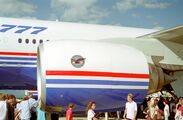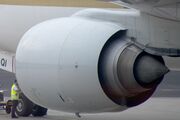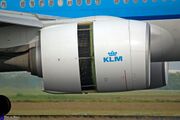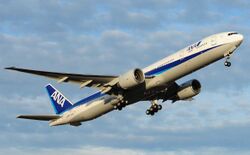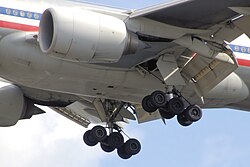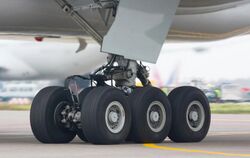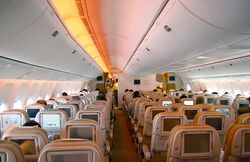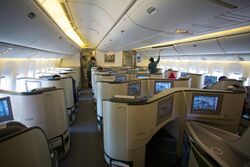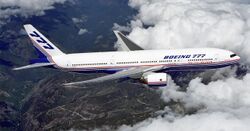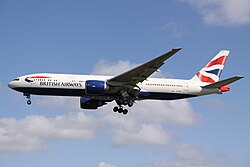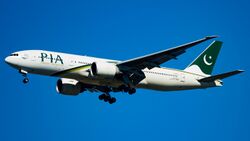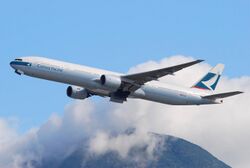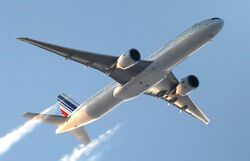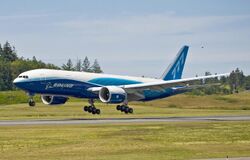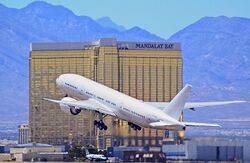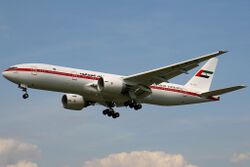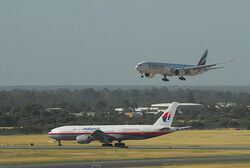Engineering:Boeing 777
| Boeing 777 | |
|---|---|

| |
| A Boeing 777-200ER of United Airlines, the launch customer of the 777 | |
| Role | Wide-body jet airliner |
| National origin | United States |
| Manufacturer | Boeing Commercial Airplanes |
| First flight | June 12, 1994 |
| Introduction | June 7, 1995, with United Airlines |
| Status | In service |
| Primary users | Emirates United Airlines Cathay Pacific Air France |
| Produced | 1993–present |
| Number built | 1,571 through September 2018[1] |
| Developed into | Boeing 777X |
The Boeing 777 is a long-range wide-body twin-engine jet airliner developed and manufactured by Boeing Commercial Airplanes. It is the world's largest twinjet and has a typical seating capacity of 314 to 396 passengers, with a range of 5,240 to 8,555 nautical miles (9,704 to 15,844 km). Commonly referred to as the "Triple Seven",[2][3] its distinguishing features include the large–diameter turbofan engines, long raked wings, six wheels on each main landing gear, fully circular fuselage cross-section,[4] and a blade-shaped tail cone.[5] Developed in consultation with eight major airlines, the 777 was designed to replace older wide-body airliners and bridge the capacity difference between Boeing's 767 and 747. Boeing's first fly-by-wire airliner, it has computer-mediated controls. It was also the first commercial aircraft to be designed entirely with computer-aided design.
The 777 is produced in two fuselage lengths (As of 2018). The original 777-200 variant entered commercial service in 1995, followed by the extended-range 777-200ER in 1997. The stretched 777-300, which is 33.25 ft (10.1 m) longer, followed in 1998. The initial 777-200, extended-range -200ER, and -300 versions are equipped with General Electric GE90, Pratt & Whitney PW4000, or Rolls-Royce Trent 800 engines. They have since been collectively referred to as 777 Classics.[6] The extended-range 777-300ER and ultra long-range 777-200LR variants entered service in 2004 and 2006 respectively, while the 777F, a freighter version, debuted in February 2009; these second-generation variants all feature high-output GE90 engines and extended raked wingtips. The 777-200LR is one of the world's longest-range airliners, able to fly more than halfway around the globe and holds the record for the longest distance flown non-stop by a commercial aircraft.[7][8] In November 2013, Boeing announced the development of the third-generation of the 777, the 777X, consisting of the 777-8 and 777-9 variants. The 777X features composite folding wings and GE9X engines plus further technologies developed for the Boeing 787, and is scheduled to enter service by 2020.
The 777 first entered commercial service with United Airlines on June 7, 1995. The 777 has received more orders than any other wide-body airliner; (As of July 2018), more than 60 customers had placed orders for 1,988 aircraft of all variants, with 1,559 delivered.[1] The most common and successful variant is the 777-300ER[9] with 789 delivered and 834 orders;[1] Emirates operates the largest 777 fleet, with 163 passenger and freighter aircraft (As of July 2018).[10] The 777 has been involved in six hull losses (As of October 2016); the Asiana Airlines Flight 214 accident in July 2013 was its first fatal crash in 18 years of service, and the shootdown of Malaysia Airlines Flight 17 in July 2014 was its deadliest crash.
The 777 ranks as one of Boeing's best-selling models, making it the most-produced Boeing wide-body jet, surpassing the Boeing 747.[11] Airlines have acquired the type as a comparatively fuel-efficient alternative to other wide-body jets and have increasingly deployed the aircraft on long-haul transoceanic routes. Direct market competitors include the Airbus A330-300, the Airbus A350 XWB, and the out-of-production A340 and McDonnell Douglas MD-11. The 787 Dreamliner, which entered service in 2011, shares design features with the 777.
Development
Background
In the early 1970s, the Boeing 747, McDonnell Douglas DC-10, and the Lockheed L-1011 TriStar became the first generation of wide-body passenger airliners to enter service.[12] In 1978, Boeing unveiled three new models: the twin-engine Boeing 757 to replace its 727, the twin-engine 767 to challenge the Airbus A300, and a trijet 777 concept to compete with the DC-10 and L-1011.[13][14][15] The mid-size 757 and 767 launched to market success, due in part to 1980s' extended-range twin-engine operational performance standards (ETOPS) regulations governing transoceanic twinjet operations.[16] These regulations allowed twin-engine airliners to make ocean crossings at up to three hours' distance from emergency diversionary airports.[17] Under ETOPS rules, airlines began operating the 767 on long-distance overseas routes that did not require the capacity of larger airliners.[16] The trijet 777 was later dropped, following marketing studies that favored the 757 and 767 variants.[18] Boeing was left with a size and range gap in its product line between the 767-300ER and the 747-400.[19]
By the late 1980s, DC-10 and L-1011 models were approaching retirement age, prompting manufacturers to develop replacement designs.[20] McDonnell Douglas was working on the MD-11, a stretched and upgraded successor of the DC-10,[20] while Airbus was developing its A330 and A340 series.[20] In 1986, Boeing unveiled proposals for an enlarged 767, tentatively named 767-X,[21] to target the replacement market for first-generation wide-bodies such as the DC-10,[17] and to complement existing 767 and 747 models in the company lineup.[22] The initial proposal featured a longer fuselage and larger wings than the existing 767,[21] along with winglets.[23] Later plans expanded the fuselage cross-section but retained the existing 767 flight deck, nose, and other elements.[21]
Airline customers were uninterested in the 767-X proposals, and instead wanted an even wider fuselage cross-section, fully flexible interior configurations, short- to intercontinental-range capability, and an operating cost lower than any 767 stretch.[17] Airline planners' requirements for larger aircraft had become increasingly specific, adding to the heightened competition among aircraft manufacturers.[20] By 1988, Boeing realized that the only answer was a new clean–sheet design, which became the 777 twinjet.[24] The company opted for the twin-engine configuration given past design successes, projected engine developments, and reduced-cost benefits.[25] On December 8, 1989, Boeing began issuing offers to airlines for the 777.[21]
Design effort
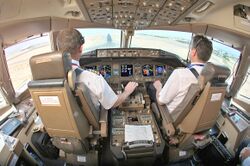
The design phase for the new twinjet was different from Boeing's previous commercial jetliners. For the first time, eight major airlines – All Nippon Airways, American Airlines, British Airways, Cathay Pacific, Delta Air Lines, Japan Airlines, Qantas, and United Airlines – had a role in the development.[26] This was a departure from industry practice, where manufacturers typically designed aircraft with minimal customer input.[27] The eight airlines that contributed to the design process became known within Boeing as the "Working Together" group.[26] At the first group meeting in January 1990, a 23-page questionnaire was distributed to the airlines, asking what each wanted in the design.[17] By March 1990, Boeing and the airlines had decided upon a basic design configuration: a cabin cross-section close to the 747's, capacity up to 325 passengers, flexible interiors, a glass cockpit, fly-by-wire controls, and 10 percent better seat-mile costs than the A330 and MD-11.[17] Boeing selected its Everett factory in Washington, home of 747 production, as the 777's final assembly site.[28]
On October 14, 1990, United Airlines became the 777's launch customer when it placed an order for 34 Pratt & Whitney-powered aircraft valued at US$11 billion with options on an additional 34.[29][30] The development phase coincided with United's replacement program for its aging DC-10s.[31] United required that the new aircraft be capable of flying three different routes: Chicago to Hawaii, Chicago to Europe, and non-stop from Denver, a hot and high airport, to Hawaii.[31] ETOPS certification was also a priority for United,[32] given the overwater portion of United's Hawaii routes.[29] In January 1993, a team of United developers joined other airline teams and Boeing designers at the Everett factory.[33] The 240 design teams, with up to 40 members each, addressed almost 1,500 design issues with individual aircraft components.[34] The fuselage diameter was increased to suit Cathay Pacific, the baseline model grew longer for All Nippon Airways, and British Airways' input led to added built-in testing and interior flexibility,[17] along with higher operating weight options.[35]
The 777 was the first commercial aircraft designed entirely by computer.[22][29][36] Each design drawing was created on a three-dimensional CAD software system known as CATIA, sourced from Dassault Systemes and IBM.[37] This lets engineers assemble a virtual aircraft, in simulation, to check for interference and verify that the thousands of parts fit properly—thus reducing costly rework.[38] Boeing developed its own high-performance visualization system, FlyThru, later called IVT (Integrated Visualization Tool) to support large-scale collaborative engineering design reviews, production illustrations, and other uses of the CAD data outside of engineering.[39] Boeing was initially not convinced of CATIA's abilities and built a physical mock-up of the nose section to verify its results. The test was so successful that additional mock-ups were canceled.[40]
Production and testing
The production process included substantial international content, an unprecedented level of global subcontracting for a Boeing jetliner,[41] later exceeded by the 787.[42] International contributors included Mitsubishi Heavy Industries and Kawasaki Heavy Industries (fuselage panels),[43] Fuji Heavy Industries, Ltd. (center wing section),[43] Hawker de Havilland (elevators), and Aerospace Technologies of Australia (rudder).[44] An agreement between Boeing and the Japan Aircraft Development Corporation, representing Japanese aerospace contractors, made the latter risk-sharing partners for 20 percent of the entire development program.[41] The initial 777-200 model was launched with propulsion options from three manufacturers, General Electric, Pratt & Whitney, and Rolls-Royce,[45] giving the airlines their choice of engines from competing firms.[46] Each manufacturer agreed to develop an engine in the 77,000 lbf (340 kN) and higher thrust class (a measure of jet engine output) for the world's largest twinjet.[45]
To accommodate production of its new airliner, Boeing doubled the size of the Everett factory at the cost of nearly US$1.5 billion[29] to provide space for two new assembly lines.[31] New production methodologies were developed, including a turn machine that could rotate fuselage subassemblies 180 degrees, giving workers access to upper body sections.[37] Major assembly of the first aircraft began on January 4, 1993.[47] By the start of production, the program had amassed 118 firm orders, with options for 95 more from 10 airlines.[48] Total investment in the program was estimated at over US$4 billion from Boeing, with an additional US$2 billion from suppliers.[49]
On April 9, 1994, the first 777, line number WA001, was rolled out in a series of 15 ceremonies held during the day to accommodate the 100,000 invited guests.[50] The first flight took place on June 12, 1994,[51] under the command of chief test pilot John E. Cashman.[52] This marked the start of an 11-month flight test program that was more extensive than testing for any previous Boeing model.[53] Nine aircraft fitted with General Electric, Pratt & Whitney, and Rolls-Royce engines[51] were flight tested at locations ranging from the desert airfield at Edwards Air Force Base in California[54] to frigid conditions in Alaska, mainly Fairbanks International Airport.[55] To satisfy ETOPS requirements, eight 180-minute single-engine test flights were performed.[56] The first aircraft built was used by Boeing's nondestructive testing campaign from 1994 to 1996, and provided data for the -200ER and -300 programs.[57] At the successful conclusion of flight testing, the 777 was awarded simultaneous airworthiness certification by the U.S. Federal Aviation Administration (FAA) and European Joint Aviation Authorities (JAA) on April 19, 1995.[51]
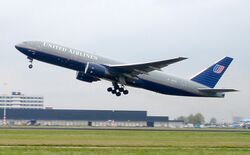
Entry into service
Boeing delivered the first 777 to United Airlines on May 15, 1995.[59][60] The FAA awarded 180-minute ETOPS clearance ("ETOPS-180") for the Pratt & Whitney PW4084-engined aircraft on May 30, 1995, making it the first airliner to carry an ETOPS-180 rating at its entry into service.[61] The first commercial flight took place on June 7, 1995, from London Heathrow Airport to Dulles International Airport near Washington, D.C.[62] Longer ETOPS clearance of 207 minutes was approved in October 1996.[63]
On November 12, 1995, Boeing delivered the first model with General Electric GE90-77B engines to British Airways,[64] which entered service five days later.[65] Initial service was affected by gearbox bearing wear issues, which caused British Airways to temporarily withdraw its 777 fleet from transatlantic service in 1997,[65] returning to full service later that year.[54] General Electric subsequently announced engine upgrades.[54]
The first Rolls-Royce Trent 877-powered aircraft was delivered to Thai Airways International on March 31, 1996,[64] completing the introduction of the three powerplants initially developed for the airliner.[66] Each engine-aircraft combination had secured ETOPS-180 certification from the point of entry into service.[67] By June 1997, orders for the 777 numbered 323 from 25 airlines, including satisfied launch customers that had ordered additional aircraft.[51] Operations performance data established the consistent capabilities of the twinjet over long-haul transoceanic routes, leading to additional sales.[68] By 1998, the 777 fleet had approached 900,000 flight hours.[69] Boeing states that the 777 fleet has a dispatch reliability (rate of departure from the gate with no more than 15 minutes delay due to technical issues) above 99 percent.[70][71][72][73]
Initial derivatives
After the original model, Boeing developed an increased gross weight variant of the 777-200 with greater range and payload capability.[74] Initially named 777-200IGW,[75] the 777-200ER first flew on October 7, 1996,[76] received FAA and JAA certification on January 17, 1997,[77] and entered service with British Airways on February 9, 1997.[77] Offering greater long-haul performance, the variant became the most widely ordered version of the aircraft through the early 2000s.[74] On April 2, 1997, a Malaysia Airlines -200ER named "Super Ranger" broke the great circle "distance without landing" record for an airliner by flying eastward from Boeing Field, Seattle to Kuala Lumpur, a distance of 10,823 nautical miles (20,044 km; 12,455 mi), in 21 hours and 23 minutes.[69]
Following the introduction of the -200ER, Boeing turned its attention to a stretched version of the airliner. On October 16, 1997, the 777-300 made its first flight.[76] At 242.4 ft (73.9 m) in length, the -300 became the longest airliner yet produced (until the A340-600), and had a 20 percent greater overall capacity than the standard length model.[78] The -300 was awarded type certification simultaneously from the FAA and JAA on May 4, 1998,[79] and entered service with launch customer Cathay Pacific on May 27, 1998.[76][80]
The first generation of Boeing 777 models, the -200, -200ER, and -300 have since been known collectively known as Boeing 777 Classics.[6]
Second generation models
From the program's start, Boeing had considered building ultra-long-range variants.[82] Early plans centered on a 777-100X proposal,[83] a shortened variant of the -200 with reduced weight and increased range,[83] similar to the 747SP.[84] However, the -100X would have carried fewer passengers than the -200 while having similar operating costs, leading to a higher cost per seat.[83][84] By the late 1990s, design plans shifted to longer-range versions of existing models.[83] In March 1997, the Boeing board approved the 777-200X/300X specifications: 298 passengers in three classes over 8,600 nmi (15,900 km) for the 200X and 6,600 nmi (12,200 km) with 355 passengers in a tri-class layout for the 300X, with design freeze planned in May 1998, 200X certification in August 2000, and introduction in September and in January 2001 for the 300X.[85]
A more powerful engine in the thrust class of 100,000 lbf (440 kN) was required, leading to talks between Boeing and engine manufacturers. General Electric offered to develop the GE90-115B engine,[46] while Rolls-Royce proposed developing the Trent 8104 engine.[86] In 1999, Boeing announced an agreement with General Electric, beating out rival proposals.[46] Under the deal with General Electric, Boeing agreed to only offer GE90 engines on new 777 versions.[46]
On February 29, 2000, Boeing launched its next-generation twinjet program,[87] initially called 777-X,[82] and began issuing offers to airlines.[74] Development was slowed by an industry downturn during the early 2000s.[76] The first model to emerge from the program, the 777-300ER, was launched with an order for ten aircraft from Air France,[88] along with additional commitments.[74] On February 24, 2003, the -300ER made its first flight, and the FAA and EASA (European Aviation Safety Agency, successor to the JAA) certified the model on March 16, 2004.[89] The first delivery to Air France took place on April 29, 2004.[76] The -300ER, which combined the -300's added capacity with the -200ER's range, became the top-selling 777 variant in the late 2000s,[90] benefitting as airlines replaced comparable four-engine models with twinjets for their lower operating costs.[91]
The second long-range model, the 777-200LR, rolled out on February 15, 2005, and completed its first flight on March 8, 2005.[76] The -200LR was certified by both the FAA and EASA on February 2, 2006,[92] and the first delivery to Pakistan International Airlines occurred on February 26, 2006.[93] On November 10, 2005, the first -200LR set a record for the longest non-stop flight of a passenger airliner by flying 11,664 nautical miles (21,602 km) eastward from Hong Kong to London.[8] Lasting 22 hours and 42 minutes, the flight surpassed the -200LR's standard design range and was logged in the Guinness World Records.[7]
The production freighter model, the 777F, rolled out on May 23, 2008.[94] The maiden flight of the 777F, which used the structural design and engine specifications of the -200LR[95] along with fuel tanks derived from the -300ER, occurred on July 14, 2008.[96] FAA and EASA type certification for the freighter was received on February 6, 2009,[97] and the first delivery to launch customer Air France took place on February 19, 2009.[98][99]
Updates and improvements
The smaller Boeing 787 was the first stage of a replacement aircraft initiative called the Boeing Yellowstone Project.[100] Reportedly, the 777 could eventually be replaced by a new aircraft family, Yellowstone 3, which would draw upon technologies from the 787.[101]
By the late 2000s, the 777 was facing increased potential competition from Airbus' planned A350 XWB and internally from proposed 787 variants,[101] both airliners that promise fuel efficiency improvements. As a consequence, the 777-300ER received an engine and aerodynamics improvement package for reduced drag and weight.[102] In 2010, the variant further received a 5,000 lb (2,300 kg) maximum zero-fuel weight increase, equivalent to a higher payload of 20–25 passengers; its GE90-115B1 engines received a 1–2.5 percent thrust enhancement for increased takeoff weights at higher-altitude airports.[102] More changes were targeted for late 2012, including possible extension of the wingspan,[102] along with other major changes, including a composite wing, new powerplant, and different fuselage lengths.[102][103][104] Emirates was reportedly working closely with Boeing on the project, possibly being the launch customer for new 777 versions.[105] China Airlines ordered ten 777-300ER aircraft to replace 747-400s on routes between Taipei and Los Angeles and New York City , telling Aviation Week and Space Technology that the 777-300ER's per seat cost is about 20% lower than the 747's costs (varying due to fuel prices).[106] Four of the 777 aircraft were already flying as of February 2015.
Boeing has worked with General Electric to offer a 2% improvement in fuel efficiency to new aircraft beginning in 2016. GE will improve the fan module and the high pressure compressor stage-1 blisk in the GE-90-115 turbofan, as well as reduce clearances between the tips of the turbine blades and the shroud during cruise. These improvements, of which the latter is the most important and was derived from work to develop the 787, will, GE says, lower fuel burn by 0.5%. Boeing's wing modification will deliver the remainder. Boeing stated that every 1% improvement in the 777-300ER's fuel burn translates into being able to fly the aircraft another 75 nautical miles on the same load of fuel, or add ten passengers or 2,400 lb of cargo to a "load limited" flight.[107]
In March 2015, additional details of the improvement package were published in Aviation Week & Space Technology. The 777-300ER is to shed 1,800 lb. Boeing will replace the fuselage crown with tie rods and composite integration panels, similar to those used on the 787. New flight control software is to eliminate the need for the tail skid by keeping the tail off the runway surface regardless of the extent to which pilots command the elevators. Boeing is also redesigning the inboard flap fairings to reduce drag by reducing pressure on the underside of the wing. The outboard raked wingtip is to have a divergent trailing edge, described as a "poor man's airfoil" by Boeing; this originally developed for the McDonnell Douglas MD-12 project. Another change involves elevator trim bias. These changes are to increase fuel efficiency and allow airlines to add 14 additional seats to the airplane, increasing per seat fuel efficiency by 5%.[108]
Production
Initially second to the 747 as Boeing's most profitable jetliner,[109] the 777 became the company's most lucrative model in the 2000s.[110] Program sales accounted for an estimated US$400 million of Boeing's pretax earnings in 2000, US$50 million more than the 747.[109] By 2004, the airliner accounted for the bulk of wide-body revenues for the Boeing Commercial Airplanes division.[111] In 2007, orders for second-generation 777 models approached 350 aircraft,[101] and in November of that year, Boeing announced that all production slots were sold out to 2012.[91] The program backlog of 356 orders was valued at US$95 billion at list prices in 2008.[112]
In 2010, Boeing announced plans to increase production from 5 aircraft per month to 7 aircraft per month by mid-2011, and 8.3 per month by early 2013.[113] Complete assembly of each 777-300ER requires 49 days.[114] In November 2011, assembly began on the 1,000th 777, a -300ER model for Emirates;[114] which was rolled out in March 2012.[115]
By April 2014, with cumulative sales surpassing those of the 747, the 777 became the best-selling wide-body airliner; at existing production rates, the aircraft was on track to become the most-delivered wide-body airliner by mid-2016.[116]
Mindful of the long time required to bring the 777X to the market, Boeing continued to develop improvement packages which improve fuel efficiency, as well as lower prices for the existing product. As of February 2015, the backlog of undelivered 777s totals 278 aircraft, representing just under three years of current production at 8.3 aircraft per month,[117] causing Boeing to ponder the 2018-2020 time frame. In January 2015, United Airlines ordered 10 Boeing 777-300ERs, normally costing around $150 million each but paid around $130 million, a discount to bridge the production gap to the 777X.[118]
In January 2016, Boeing confirmed plans to reduce the production rate of the 777 family from 8.3 per month to 7 per month in 2017 to help close the production gap between the 777 and 777X created by a lack of new orders.[119] In 2018, assembling test 777-9 aircraft is expected to lower output to an effective rate of 5.5 per month.[120] Boeing will drop 777 production to five per month in August 2017.[121]
As of 2018, Boeing lists prices for the 777-200ER, -200LR, 777F, and -300ER. The -200ER is the only Classic variant available.[122]
Third generation models (777X program)
Launched in November 2013, the under development 777X will be re-engined with new GE9X turbofans, will have a new carbon fiber reinforced polymer wings with folding wingtips and a denser cabin. The longer 777-9, seating 414 over 7,600 nmi (14,075 km), should fly in the first quarter of 2019 and be delivered from December 2019, while the shorter 777-8 would seat 365 over 8,700 nmi (16,110 km).
Design
Boeing introduced a number of advanced technologies with the 777 design, including fully digital fly-by-wire controls,[123] fully software-configurable avionics, Honeywell LCD glass cockpit flight displays,[124] and the first use of a fiber optic avionics network on a commercial airliner.[125] Boeing made use of work done on the cancelled Boeing 7J7 regional jet,[126] which utilized similar versions of the chosen technologies.[126] In 2003, Boeing began offering the option of cockpit electronic flight bag computer displays.[127] In 2013, Boeing announced that the upgraded 777X models would incorporate airframe, systems, and interior technologies from the 787.[128]
Fly-by-wire
In designing the 777 as its first fly-by-wire commercial aircraft, Boeing decided to retain conventional control yokes rather than change to sidestick controllers as used in many fly-by-wire fighter aircraft and in many Airbus airliners.[123] Along with traditional yoke and rudder controls, the cockpit features a simplified layout that retains similarities to previous Boeing models.[129] The fly-by-wire system also incorporates flight envelope protection, a system that guides pilot inputs within a computer-calculated framework of operating parameters, acting to prevent stalls, overspeeds, and excessively stressful maneuvers.[123] This system can be overridden by the pilot if deemed necessary.[123] The fly-by-wire system is supplemented by mechanical backup.[130]
Airframe and systems
The wings on the 777 feature a supercritical airfoil design that is swept back at 31.6 degrees and optimized for cruising at Mach 0.83 (revised after flight tests up to Mach 0.84).[131] The wings are designed with increased thickness and a longer span than previous airliners, resulting in greater payload and range, improved takeoff performance, and a higher cruising altitude.[51] The wings also serve as fuel storage, with longer-range models able to carry up to 47,890 US gallons (181,300 L) of fuel.[132] This capacity allows the 777-200LR to operate ultra-long-distance, trans-polar routes such as Toronto to Hong Kong.[133] In 2013, a new wing made of composite materials was introduced for the upgraded 777X, with a wider span and design features based on the 787's wings.[128]
Unlike smaller airliners like the Boeing 737, no current 777 wings have winglets; instead, the exceptionally long raked wings of the 777 serve the same drag-reducing function. Large folding wingtips, 21 feet (6.40 m) long, were offered when the 777 was first launched, to appeal to airlines who might use gates made to accommodate smaller aircraft, but no airline purchased this option.[134] Folding wingtips reemerged as a design feature at the announcement of the upgraded 777X in 2013. Smaller folding wingtips of 11 feet (3.35 m) in length will allow 777X models to use the same airport gates and taxiways as earlier 777s.[128] These smaller folding wingtips are less complex than those proposed for earlier 777s, and internally only affect the wiring needed for wingtip lights.[128]
The airframe incorporates the use of composite materials, which comprise nine percent of its original structural weight (all models outside the 777-8 and 777-9).[135] Elements made from composite material include the cabin floor and rudder. The main fuselage cross-section is circular[136] and tapers rearward into a blade-shaped tail cone with a port-facing auxiliary power unit.[5] The aircraft also features the largest landing gear and the biggest tires ever used in a commercial jetliner.[137] The six-wheel bogies are designed to spread the load of the aircraft over a wide area without requiring an additional centerline gear. This helps reduce weight and simplifies the aircraft's braking and hydraulic systems. Each tire of a 777-300ER six-wheel main landing gear can carry a load of 59,490 lb (26,980 kg), which is heavier than other wide-bodies such as the 747-400.[138] The aircraft has triple redundant hydraulic systems with only one system required for landing.[139] A ram air turbine –a small retractable propeller which can provide emergency power– is also fitted in the wing root fairing.[140]
Interior
The original 777 interior, also known as the Boeing Signature Interior, features curved panels, larger overhead bins, and indirect lighting.[65] Seating options range from four[141] to six abreast in first class up to 10 across in economy.[142] The 777's windows were the largest of any current commercial airliner until the 787, and measure 15-inch (380 mm) by 10-inch (250 mm) in size (all models outside the 777-8 and -9).[143] The cabin also features "Flexibility Zones", which entails deliberate placement of water, electrical, pneumatic, and other connection points throughout the interior space, allowing airlines to move seats, galleys, and lavatories quickly and more easily when adjusting cabin arrangements.[142] Several aircraft have also been fitted with VIP interiors for non-airline use.[144] Boeing designed a hydraulically damped toilet seat cover hinge that closes slowly.[145]
In 2003, Boeing introduced overhead crew rests as an option on the 777.[146] Located above the main cabin and connected via staircases, the forward flight crew rest contains two seats and two bunks, while the aft cabin crew rest features multiple bunks.[146] The Signature Interior has since been adapted for other Boeing wide-body and narrow-body aircraft, including 737NG, 747-400, 757-300, and newer 767 models, including all 767-400ER models.[147][148] The 747-8 and 767-400ER have also adopted the larger, more rounded windows of the original 777.
In 2011, Flight International reported that Boeing is considering replacing the Signature Interior on the 777 with a new interior similar to that on the 787, as part of a move towards a "common cabin experience" across all Boeing platforms.[149] With the launch of the 777X in 2013, Boeing confirmed that the aircraft would be receiving a new interior featuring 787 cabin elements and larger windows.[128] Further details released in 2014 included re-sculpted cabin sidewalls for greater interior room, noise-dampening technology, and higher cabin humidity.[150]
Variants
Boeing uses two characteristics – fuselage length and range – to define its 777 models.[19] Passengers and cargo capacity varies by fuselage length: the 777-300 stretched the base 777-200 in 1998. Three range categories were defined: the A-market would cover domestic and regional operations, the B-market would cover routes from Europe to the US West coast and the C-market the longest transpacific routes.[151] The A-market would be covered by a 4,200 nmi (7,800 km) range, 234 t (516,000 lb) MTOW aircraft for 353 to 374 passengers powered by 316 kN (71,000 lbf) engines, followed by a 6,600 nmi (12,200 km) B-market range for 286 passengers in three-class, with 365 kN (82,000 lbf) unit thrust and 263 t (580,000 lb) of MTOW, an A340 competitor, basis of an A-market 409 to 434 passengers stretch, and eventually a 7,600 nmi (14,000 km) C-market with 400 kN (90,000 lbf) engines.[152]
When referring to different variants, the International Air Transport Association (IATA) code collapses the 777 model designator and the -200 or -300 variant designator to "772" or "773".[153] The International Civil Aviation Organization (ICAO) aircraft type designator system adds a preceding manufacturer letter for "B772" or "B773".[154] Designations may append a range identifier like "B77W" for the 777-300ER by the ICAO,[154] "77W" for the IATA.[153] Other notations include "773ER"[155] and "773B" for the -300ER.[156]
| ICAO designation[154] | Model series |
|---|---|
| B772 | 777-200/200ER |
| B77L | 777-200LR/F |
| B773 | 777-300 |
| B77W | 777-300ER |
| B778 | 777-8 |
| B779 | 777-9 |
777-200
The initial 777-200 made its maiden flight on June 12, 1994 and was first delivered to United Airlines on May 15, 1995.[76] With a 545,000 lb (247,200 kg) MTOW and 77,000 lbf (340 kN) engines, it has a range of 5,240 nautical miles (9,700 km) with 305 passengers in three-class.[157] The -200 was aimed at U.S. domestic airlines.[19] Nine different -200 customers have taken delivery of 88 aircraft,[1] with 55 in airline service (As of July 2018).[10] The competing Airbus is the A330-300.[158]
777-200ER
The B-market 777-200ER ("ER" for Extended Range), originally known as the 777-200IGW (increased gross weight), has additional fuel capacity and an increased MTOW for transatlantic routes.[75] With a 298.46 t (658,000 lb) MTOW and 93,700 lbf (417 kN) engines, it has a 7,065 nmi (13,084 km) range.[159] It was delivered first to British Airways on February 6, 1997.[76] Thirty-three customers received 422 deliveries, with no unfilled orders (As of February 2018).[1] (As of July 2018), 338 examples of the -200ER are in airline service.[10] Boeing proposes the 787-10 to replace it.[160] It competes with the A340-300[161] and the A350-900.
It can be delivered de-rated with reduced engine thrust for shorter routes to lower the MTOW, reduce purchase price and landing fees (as 777-200 specifications) but can be re-rated to full standard.[162] Singapore Airlines ordered over half of its -200ERs de-rated.[162][163]
On March 17, 2003, a United Airlines flight over the Pacific Ocean carrying 255 passengers made the longest ETOPS flight diversion with only one engine in 177 minutes.[164][165] A British Airways 777-200ER flew the fastest New York to London subsonic flight at 5 hours and 16 minutes in January 2015 due to strong tail winds.[166][167][lower-alpha 1][168]
777-200LR
The 777-200LR ("LR" for Longer Range), the C-market model, entered service in 2006 as one of the longest-range commercial airliners.[169][170] Boeing named it Worldliner as it can connect almost any two airports in the world,[8] although it is subject to ETOPS restrictions.[171] It holds the world record for the longest nonstop flight by a commercial airliner.[8] It has a maximum design range of 8,555 nautical miles (15,844 km) (As of 2017).[159] The -200LR was intended for ultra long-haul routes such as Los Angeles to Singapore.[82]
Developed alongside the -300ER, the -200LR features an increased MTOW and three optional auxiliary fuel tanks in the rear cargo hold.[169] Other new features include extended raked wingtips, redesigned main landing gear, and additional structural strengthening.[169] As with the -300ER and 777F, the -200LR is equipped with wingtip extensions of 12.8 ft (3.90 m).[169] The -200LR is powered by GE90-110B1 or GE90-115B turbofans.[172] The first -200LR was delivered to Pakistan International Airlines on February 26, 2006.[93][173] Eleven different -200LR customers took delivery of 59 aircraft, with no unfilled orders.[1] Airlines operated 50 of the -200LR variant (As of July 2018).[10] Delta Air Lines and Emirates are the largest operators of the LR variant, each operating 10 aircraft.[174] The closest competing aircraft from Airbus are the discontinued A340-500HGW[169] and the forthcoming A350-900ULR.[175]
777-300
Launched at the Paris Air Show on June 26, 1995, its major assembly started in March 1997 and its body was joined on July 21, it was rolled-out on September 8 and made its first flight on October 16. The 777 was designed to be stretched by 20%: 60 extra seats to almost 370 in tri-class, 75 more to 451 in two classes, or up to 550 in all-economy like the 747SR short-range variant. The 33 ft (10.1 m) stretch is done with 17 ft (5.3 m) in ten frames forward and 16 ft (4.8 m) in nine frames aft for a 242 ft (73.8 m) length, 11 ft (3.4 m) longer than the 747-400. It uses the -200IGW 45,200 US gal (171,200 L) fuel capacity and 84,000–98,000 lbf (374–436 kN) engines with a 580,000 to 661,000 lb (263.3 to 299.6 t) MTOW.[176]
It has ground maneuvering cameras for taxiing and a tailskid to rotate, while the proposed 716,000 lb (324.6 t) MTOW -300X will need a semi-levered main gear. Its overwing fuselage section 44 was strengthened, with its skin thickness going from the -200's 6.3 to 11.4 mm (0.25 to 0.45 in), and received a new evacuation door pair. Its operating empty weight with Rolls-Royce engines in typical tri-class layout is 343,300 lb (155.72 t) compared to 307,300 lb (139.38 t) for a similarly configured -200. Boeing wanted to deliver 170 -300s by 2006 and to produce 28 per year by 2002, to replace Boeing 747 Classics, burning one-third less fuel with 40% lower maintenance costs.[176]
With a 660,000 lb (299,370 kg) MTOW and 90,000 lbf (400 kN) engines, it has a range of 6,005 nautical miles (11,121 km) with 368 passengers in three-class.[157] Eight different customers have taken delivery of 60 aircraft of the variant,[1] with 48 in airline service (As of July 2018).[10] The last -300 was delivered in 2006 while the longer-range -300ER started deliveries in 2004.[1]
777-300ER
The 777-300ER ("ER" for Extended Range) is the B-market version of the -300. Its higher MTOW and increased fuel capacity permits a maximum range of 7,370 nautical miles (13,650 km) with 396 passengers in a two-class seating arrangement.[159] The 777-300ER features raked and extended wingtips, a strengthened fuselage and wings and a modified main landing gear.[177] Its wings have an aspect ratio of 9.0.[178] It is powered by the GE90-115B turbofan, the world's most powerful jet engine with a maximum thrust of 115,300 lbf (513 kN).[179] Following flight testing, aerodynamic refinements have reduced fuel burn by an additional 1.4%.[90][180] At Mach 0.839 (495 kn; 916 km/h), FL300, -59 °C and at a 513,400 lb (232.9 t) weight, it burns 17,300 lb (7.8 t) of fuel per hour, its operating empty weight is 371,600 lb (168.6 t).[181]
Since its launch, the -300ER has been a primary driver of the twinjet's sales past the rival A330/340 series.[9] Its direct competitors have included the Airbus A340-600 and the A350-1000.[101] Using two engines produces a typical operating cost advantage of around 8–9% for the -300ER over the A340-600.[182] Several airlines have acquired the -300ER as a 747-400 replacement amid rising fuel prices given its 20% fuel burn advantage.[91] The -300ER has an operating cost of $44 per seat hour, compared to an Airbus A380's roughly $50 per seat hour (hourly cost is about $26,000), and $90 per seat hour for a Boeing 747-400 (As of November 2015).[183]
The first -300ER was delivered to Air France on April 29, 2004.[184] The -300ER is the best-selling 777 variant, having surpassed the -200ER in orders in 2010 and deliveries in 2013.[1] (As of July 2018), 784 Boeing 777-300ER aircraft were in service.[10] (As of July 2018), -300ER deliveries to 45 different customers totalled 789, with 45 unfilled orders.[1]
In July 2018, Boeing was studying a 777-300ER freighter conversion, targeted for the volumetric market instead of the density market served by the 777F. After having considered a -200ER P2F program, Boeing hopes to conclude its study by fall as the 777X replacing aging -300ERs from 2020 will generate feedstock.[185]
777 Freighter
The 777 Freighter (777F) is an all-cargo version of the twinjet, and shares features with the -200LR; these include its airframe, engines,[186] and fuel capacity.[132] With a maximum payload of 224,900 lb (102,000 kg) (similar to the 243,000 lb (110,000 kg) of the Boeing 747-200F), it has a range of 4,970 nmi (9,200 km).[159] Greater range is possible if less cargo weight is carried.[187]
As the aircraft promises improved operating economics compared to older freighters,[91] airlines have viewed the 777F as a replacement for freighters such as the Boeing 747-200F, McDonnell Douglas MD-10 and McDonnell Douglas MD-11F.[95][188] The first 777F was delivered to Air France on February 19, 2009.[98] (As of July 2018), 141 freighters had been delivered to 17 different customers, with 58 unfilled orders.[1] Operators had 140 of the 777F in service (As of July 2018).[10]
In the 2000s, Boeing began studying the conversion of 777-200ER and -200 passenger airliners into freighters, under the name 777 BCF (Boeing Converted Freighter).[189] The company has been in discussion with several airline customers, including FedEx Express, UPS Airlines, and GE Capital Aviation Services, to provide launch orders for a 777 BCF program.[190]
777-8 and -9
Launched in November 2013, the under development 777X will feature GE9X new engines, new carbon fiber wings with folding wingtips and a denser cabin. The longer 777-9, seating 414 over 7,600 nmi (14,075 km), should fly in the first quarter of 2019 and be delivered from December 2019, while the shorter 777-8 would seat 365 over 8,700 nmi (16,110 km).
Government and corporate
Versions of the 777 have been acquired by government and private customers. The main purpose has been for VIP transport, including as an air transport for heads of state, although the aircraft has also been proposed for other military applications.
- 777 Business Jet (777 VIP) – the Boeing Business Jet version of the 777 that is sold to corporate customers. Boeing has received orders for 777 VIP aircraft based on the 777-200LR and 777-300ER passenger models.[191][192] The aircraft are fitted with private jet cabins by third party contractors,[191] and completion may take 3 years.[193]
- 777 Tanker (KC-777) – the KC-777 is a proposed tanker version of the 777. In September 2006, Boeing announced that it would produce the KC-777 if the United States Air Force (USAF) required a larger tanker than the KC-767, able to transport more cargo or personnel.[194][195][196] In April 2007, Boeing offered its 767-based KC-767 Advanced Tanker instead of the KC-777 to replace the smaller Boeing KC-135 Stratotanker under the USAF's KC-X program.[197] Boeing officials have described the KC-777 as suitable for the related KC-Z program to replace the wide-body McDonnell Douglas KC-10 Extender.[198]
- In 2014, the Japanese government chose to procure two 777-300ERs to serve as the official air transport for the Emperor of Japan and Prime Minister of Japan.[199] The aircraft, to be operated by the Japan Air Self-Defense Force under the callsign Japanese Air Force One , are scheduled to enter service in 2019 and replace two 747-400s. Besides VIP transport, the 777s are also intended for use in emergency relief missions.[199]
- 777s have served as official government transports for nations including Gabon (VIP-configured 777-200ER),[200] Turkmenistan (VIP-configured 777-200LR),[201] and the United Arab Emirates (VIP-configured 777-200ER and 777-300ER operated by Abu Dhabi Amiri Flight).[192] Prior to returning to power as Prime Minister of Lebanon, Rafic Hariri acquired a 777-200ER as an official transport.[202]
- In 2014, the USAF examined the possibility of adopting modified 777-300ERs or 777-9Xs to replace the Boeing 747-200 aircraft used as Air Force One .[203] Although the USAF had preferred a four engine aircraft, this was mainly due to precedent (the existing aircraft were purchased when the 767 was just beginning to prove itself with ETOPS; decades later, the 777 and other twin jets established a comparable level of performance as quad-jet aircraft).[203] Ultimately, the air force decided against the 777, and selected instead the Boeing 747-8 to become the next presidential aircraft.[204]
Operators
Boeing customers that have received the most 777s are Emirates, Singapore Airlines, United Airlines, ILFC, and American Airlines.[1] Emirates is the largest airline operator (As of July 2018),[10] and is the only customer to have operated all 777 variants produced, including the -200, -200ER, -200LR, -300, -300ER, and 777F.[1][205] The 1,000th 777 off the production line, a -300ER set to be Emirates' 102nd 777, was unveiled at a factory ceremony in March 2012.[115]
A total of 1,416 aircraft (all variants) were in airline service (As of July 2018), with Emirates (163), United Airlines (91), Air France (70), Cathay Pacific (69), American Airlines (67), Qatar Airways (67), British Airways (58), All Nippon Airways (50), Singapore Airlines (46), and other operators with fewer aircraft of the type.[10]
In 2017, 777 Classics are towards the end of their mainline service: with a -200 age ranging from three to 22 years, 43 Classic 777s or 7.5% of the fleet have been retired. Values of 777-200ERs have declined by 45% since January 2014, faster than Airbus A330s and Boeing 767s with 30%, due to the lack of a major secondary market but only a few budget, air charters and ACMI operators. In 2015, Richard H. Anderson, then Delta Air Lines' chairman and chief executive, said he had been offered 777-200s for less than $10 million. To keep them cost efficient, operators densify their 777s for about $10 million each, like Scoot with 402 seats in its dual-class -200s, or Cathay Pacific which switched the 3-3-3 economy layout of 777-300s to 3-4-3 to seat 396 on regional services.[6]
Orders and deliveries
Aircraft on display
- The first prototype Boeing 777-200, N7771, was retired in mid-2018 amid press reports that it was to be displayed at the Museum of Flight in Seattle. These reports were denied by the museum.[206] On September 18, 2018, Cathay Pacific and Boeing announced that N7771 would be donated to the Pima Air & Space Museum near Tucson, Arizona, where it would be placed on permanent display.[207] This aircraft, which had previously been in regular use by Cathay Pacific between 2000 and 2017, was manufactured in 1994 and was delivered to the airline after spending six years with Boeing.[208][209]
Accidents and incidents

(As of September 2018), the 777 has been involved in 26 aviation accidents and incidents,[211] including a total of seven hull-losses – one due to an aircraft that was shot down (Malaysia Airlines Flight 17) – resulting in 541 fatalities along with three hijackings.[212][213] The first fatality involving the twinjet occurred in a fire while an aircraft was being refueled at Denver International Airport in the United States on September 5, 2001, during which a ground worker sustained fatal burns.[214] The aircraft, operated by British Airways, suffered fire damage to the lower wing panels and engine housing; it was later repaired and returned to service.[214][215]
The type's first hull-loss occurred on January 17, 2008, when a 777-200ER with Rolls-Royce Trent 895 engines, flying from Beijing to London as British Airways Flight 38, crash-landed approximately 1,000 feet (300 m) short of Heathrow Airport's runway 27L and slid onto the runway's threshold. There were 47 injuries and no fatalities. The impact damaged the landing gear, wing roots and engines. The aircraft was written off.[216][217] The accident was attributed to ice crystals suspended in the aircraft's fuel clogging the fuel-oil heat exchanger (FOHE).[210][218] Two other minor momentary losses of thrust with Trent 895 engines occurred later in 2008.[219][220] Investigators found these were also caused by ice in the fuel clogging the FOHE. As a result, the heat exchanger was redesigned.[210][221]
On July 29, 2011, a 777-200ER scheduled to operate as EgyptAir Flight 667, suffered a cockpit fire while parked at the gate at Cairo International Airport before its departure.[222] The aircraft was evacuated with no injuries,[222] and airport fire teams extinguished the fire.[223] The aircraft sustained structural-, heat- and smoke damage, and was written off.[222][223] Investigators focused on a possible short circuit between an electrical cable and a supply hose in the cockpit crew oxygen system.[222]
On July 6, 2013, a 777-200ER operating as Asiana Airlines Flight 214, crashed while landing at San Francisco International Airport after touching down short of the runway. The 307 surviving passengers and crew on board evacuated before fire destroyed the aircraft. Two passengers, who had not been wearing their seatbelts, were ejected from the aircraft during the crash and were killed.[224] A third passenger died six days later as a result of injuries sustained during the crash.[225] These were the first fatalities in a crash involving a 777 since its entry into service in 1995.[226][225][227] The official accident investigation concluded in June 2014 that the pilots committed 20 to 30 minor to significant errors in their final approach, and that complexities of the automated controls contributed to the accident.[228][229]
On March 8, 2014, a 777-200ER carrying 227 passengers and 12 crew, en route from Kuala Lumpur to Beijing as Malaysia Airlines Flight 370, was reported missing. Air Traffic Control's last reported coordinates for the aircraft were over the South China Sea at [ ⚑ ] 6°55′15″N 103°34′43″E / 6.92083°N 103.57861°E.[230][231] After the search for the aircraft began, Malaysia's prime minister announced on March 24, 2014 that after analysis of new satellite data it was now to be assumed "beyond reasonable doubt" that the aircraft had crashed in the Indian Ocean and there were no survivors.[232][233] (As of August 2016), the cause remains unknown, but the Malaysian Government declared it was an accident in January 2015.[234][235] On July 29, 2015, an item later identified as a flaperon strongly suspected to be from the missing aircraft was found on the island of Réunion in the western Indian Ocean.[236]
The fifth hull-loss occurred on July 17, 2014, when a 777-200ER, bound for Kuala Lumpur from Amsterdam as Malaysia Airlines Flight 17 (MH17), broke up in mid-air and crashed[237] in the Donetsk province in eastern Ukraine, after being hit by an anti-aircraft missile.[238] All 298 people (283 passengers and 15 crew) on board were killed, making this the deadliest crash involving the Boeing 777. The incident was linked to the ongoing Donbass insurgency in the region.[239][240] The official accident report, released in October 2015, states that airliner was brought down by a Buk missile launched from territory held by pro-Russian separatists.[241]
On September 8, 2015, a 777-200ER caught fire during its take-off at Las Vegas McCarran International Airport as British Airways Flight 2276, after one of its General Electric GE90-85B engines suffered a serious uncontained engine failure. The take-off was aborted and all crew and passengers were evacuated with only minor injuries occurring. Investigators discovered that debris from inside the engine had punctured 'multiple' holes in the engine case.[242][243][244][245]
On May 27, 2016, an engine caught fire on a 777-300 before it was due to take off as Korean Air Flight 2708 at Tokyo International Airport, commonly known as Haneda Airport. Shortly before take-off, the Number 1 Pratt & Whitney PW4000 engine caught fire. All 17 crew members and 302 passengers evacuated safely. Fire fighters put out the fire within an hour. The incident is under investigation.[246][247][248][importance?]
On June 27, 2016, a 777-300ER suffered an oil leak in the right engine while en route from Singapore to Milan as Singapore Airlines Flight 368. It was diverted back to Singapore Changi Airport for an emergency landing. The right engine and wing caught fire during the landing roll and sustained serious fire damage. There were no injuries.[249][250]
On August 3, 2016, the sixth hull-loss of the type occurred, when a 777-300 crashed while landing and caught fire at Dubai Airport at the end of its flight as Emirates Flight 521.[251] The preliminary investigation indicated that the aircraft was attempting a landing during active wind shear conditions. The pilots initiated a go-around procedure shortly after the main wheels touched-down onto the runway, however the aircraft settled back onto the ground apparently due to late throttle application. As the undercarriage was in the process of being retracted, the aircraft landed on its rear underbody and engine nacelles, resulting in the separation of one engine, loss of control and subsequent crash.[252] There were no passenger casualties of the 300 people on board, however one airport fireman was killed fighting the fire. The aircraft's fuselage and right wing were badly damaged by the fire.[251][253]
Specifications
| Model | 777-200[172] | 777-200ER[172] | 777-200LR[132] | 777F[132] | 777-300[172] | 777-300ER[132] |
|---|---|---|---|---|---|---|
| Cockpit crew | Two | |||||
| 3-class[157] | 305 (24F/54J/227Y) | 301 (16F/58J/227Y) | 368 (30F/84J/254Y) | 365 (22F/70J/273Y) | ||
| 2-class/capacity[159] | 313 | 317 | 224,900 lb / 102,010 kg | 396 | ||
| Exit limit[254] | 440 | 11 | 550 | |||
| Length | 209 ft 1 in / 63.73 m | 242 ft 4 in / 73.86 m | ||||
| Wingspan | 199 ft 11 in / 60.93 m | 212 ft 7 in / 64.80 m | 199 ft 11 in / 60.93 m | 212 ft 7 in / 64.80 m | ||
| Wing sweep | 31.6°[255] | |||||
| Wing area | 4,605 sq ft (427.8 m2)[255] | 4,702 sq ft (436.8 m2)[256] | 4,605 sq ft (427.8 m2)[255] | 4,702 sq ft (436.8 m2)[256] | ||
| Aspect ratio | 8.68 | 9.04 | 8.68 | 9.04 | ||
| Tail height[159] | 60 ft 9 in / 18.5 m | 61 ft 1 in / 18.6 m | 60 ft 8 in / 18.5 m | |||
| Cabin width[257] | 231 in / 5.86 m | |||||
| Seat width | 18.5 in / 47 cm at 9 abreast, 17 in / 43 cm at 10 abreast | |||||
| Fuselage width | 20 ft 4 in / 6.20 m | |||||
| Maximum cargo capacity[159] | 5,330 ft³ / 150.9 m³ | 23,051 ft³ / 652.7 m³ | 7,120 ft³ / 201.6 m³ | |||
| Maximum takeoff weight (MTOW) | 545,000 lb / 247,200 kg | 656,000 lb / 297,550 kg | 766,000 lb / 347,452 kg | 766,800 lb / 347,815 kg | 660,000 lb / 299,370 kg | 775,000 lb / 351,533 kg |
| Max. landing weight | 445,000 lb / 201,840 kg | 470,000 lb / 213,180 kg | 492,000 lb / 223,168 kg | 575,000 lb / 260,816 kg | 524,000 lb / 237,680 kg | 554,000 lb / 251,290 kg |
| Operating empty weight | 299,550 lb / 135,850 kg | 304,500 lb / 138,100 kg | 320,000 lb / 145,150 kg | 318,300 lb / 144,379 kg | 353,800 lb / 160,530 kg | 370,000 lb / 167,829 kg |
| Fuel capacity | 31,000 US gal / 117,340 L / 207,700 lb / 94,240 kg | 45,220 US gal / 171,171 L / 302,270 lb / 137,460 kg | 47,890 US gal / 181,283 L / 320,863 lb / 145,538 kg | 45,220 US gal / 171,171 L / 302,270 lb / 137,460 kg | 47,890 US gal / 181,283 L / 320,863 lb / 145,538 kg | |
| Service ceiling[254] | 43,100 ft (13,100 m) | |||||
| Cruise speed | Mach 0.84 (892 km/h; 554 mph) | |||||
| Max. speed | Mach 0.89 (945 km/h; 587 mph)[258] | |||||
| Range[159] | 5,240 nmi / 9,700 km[lower-alpha 2][157] | 7,065 nmi / 13,080 km[lower-alpha 3] | 8,555 nmi / 15,843 km[lower-alpha 4] | 4,970 nmi / 9,200 km[lower-alpha 5] | 6,030 nmi / 11,165 km[lower-alpha 6][157] | 7,370 nmi / 13,649 km[lower-alpha 7] |
| Takeoff distance[lower-alpha 8] | 8,000 ft 2,440 m |
11,100 ft 3,380 m |
9,200 ft 2,800 m |
9,300 ft 2,830 m |
10,600 ft 3,230 m |
10,000 ft 3,050 m |
| Turbofan (×2) | PW 4077 RR 877 GE90-77B |
PW 4090 RR 895 GE90-94B |
GE90-110B1 GE90-115B |
PW 4098 RR 892 GE90-92B/-94B |
GE90-115B | |
| Max thrust (×2) | 77,200 lbf (343 kN) | 93,700 lbf (417 kN) | 115,300 lbf (513 kN) | 98,000 lbf (440 kN) | 115,300 lbf (513 kN) | |
See also
Related development
Aircraft of comparable role, configuration and era
- Airbus A330/A330neo
- Airbus A340
- Airbus A350 XWB
- Boeing 767
- Boeing 787 Dreamliner
- Ilyushin Il-96
- McDonnell Douglas MD-11
Related lists
- List of Boeing 777 operators
- List of Boeing 777 orders and deliveries
- List of Boeing customer codes
- List of jet airliners
- List of civil aircraft
References
Footnotes
Citations
- ↑ 1.00 1.01 1.02 1.03 1.04 1.05 1.06 1.07 1.08 1.09 1.10 1.11 1.12 Cite error: Invalid
<ref>tag; no text was provided for refs named777_O_D_summ - ↑ Robertson, David (March 13, 2009). "Workhorse Jet Has Been Huge Success with Airlines that Want to Cut Costs". The Times (London, England, United Kingdom: Times Newspapers). Archived from the original on June 12, 2011. https://web.archive.org/web/20110612140321/http://business.timesonline.co.uk/tol/business/industry_sectors/transport/article5898240.ece. Retrieved March 20, 2009.
- ↑ Grantham, Russell (February 29, 2008). "Delta's new Boeing 777 Can Fly Farther, Carry More". The Atlanta Journal-Constitution. "Delta will put the new "triple seven" — as airline folks call the jet — into service March 8.".
- ↑ Birtles 1998, pp. 52
- ↑ 5.0 5.1 Norris & Wagner 1996, p. 89
- ↑ 6.0 6.1 6.2 Ellis Taylor (1 Sep 2017). "777 Classics entering their twilight years". Flightglobal. https://www.flightglobal.com/news/articles/analysis-777-classics-entering-their-twilight-years-440697/.
- ↑ 7.0 7.1 Glenday 2007, p. 200
- ↑ 8.0 8.1 8.2 8.3 Phillips, Don (November 10, 2005). "Flight of Boeing's 777 Breaks Distance Record". International Herald Tribune. The New York Times. Archived from the original on February 3, 2015. https://web.archive.org/web/20150203152936/http://www.nytimes.com/2005/11/10/business/11air.html. Retrieved October 14, 2013.
- ↑ 9.0 9.1 "777-300ER fleet report: orders have peaked but Swiss, United and Kuwait new operators in 2016 - CAPA - Centre for Aviation". centreforaviation.com. http://centreforaviation.com/analysis/777-300er-fleet-report-orders-have-peaked-but-swiss-united-and-kuwait-new-operators-in-2016-268001. Retrieved September 6, 2016.
- ↑ 10.0 10.1 10.2 10.3 10.4 10.5 10.6 10.7 10.8 "World Airline Census 2018" (in en-GB). https://www.flightglobal.com/asset/24536.
- ↑ "Boeing: Commercial". http://www.boeing.com/commercial/.
- ↑ Wells & Rodrigues 2004, p. 146
- ↑ "The 1980s Generation". Time. August 14, 1978. Archived from the original on November 18, 2007. https://web.archive.org/web/20071118220221/http://www.time.com/time/magazine/article/0%2C9171%2C946981%2C00.html. Retrieved July 19, 2008.
- ↑ Eden 2008, pp. 98, 102–103
- ↑ "Boeing 767 and 777". Flight International. 13 May 1978. https://www.flightglobal.com/pdfarchive/view/1978/1978%20-%200788.html.
- ↑ 16.0 16.1 Eden 2008, pp. 99–104
- ↑ 17.0 17.1 17.2 17.3 17.4 17.5 Norris & Wagner 1999, p. 128
- ↑ Yenne 2002, p. 33
- ↑ 19.0 19.1 19.2 Eden 2008, p. 112
- ↑ 20.0 20.1 20.2 20.3 Norris & Wagner 1999, p. 126
- ↑ 21.0 21.1 21.2 21.3 Norris & Wagner 1999, p. 127
- ↑ 22.0 22.1 Eden 2008, p. 106
- ↑ Norris & Wagner 2001, p. 11
- ↑ Norris & Wagner 1996, pp. 9–14
- ↑ Norris & Wagner 1999, p. 129
- ↑ 26.0 26.1 Birtles 1998, pp. 13–16
- ↑ Weiner, Eric (December 19, 1990). "New Boeing Airliner Shaped by the Airlines". The New York Times. https://www.nytimes.com/1990/12/19/business/new-boeing-airliner-shaped-by-the-airlines.html. Retrieved May 8, 2011.
- ↑ Lane, Polly (December 1, 1991). "Aerospace Company May Be Rethinking Commitment To The Puget Sound Area". Seattle Times. http://community.seattletimes.nwsource.com/archive/?date=19911201&slug=1320330. Retrieved October 15, 2009.
- ↑ 29.0 29.1 29.2 29.3 Norris & Wagner 1999, p. 132
- ↑ "Business Notes: Aircraft". Time. October 29, 1990. Archived from the original on November 18, 2007. https://web.archive.org/web/20071118220227/http://www.time.com/time/magazine/article/0%2C9171%2C971474%2C00.html. Retrieved July 19, 2008.
- ↑ 31.0 31.1 31.2 Norris & Wagner 1996, p. 14
- ↑ Norris & Wagner 1996, p. 13
- ↑ Norris & Wagner 1996, p. 15
- ↑ Norris & Wagner 1996, p. 20
- ↑ "BA Gets New 777 Model". Seattle Post-Intelligencer. February 10, 1997. Archived from the original on 2012-11-05. https://web.archive.org/web/20121105222755/http://www.highbeam.com/doc/1G1-64618874.html. Retrieved 2015-07-04.
- ↑ An Introduction to Mechanical Engineering.. Cl-Engineering. p. 19. ISBN 978-1-111-57680-6. "As an example, the Boeing 777 was the first commercial airliner developed through a paperless computer-aided design process."
- ↑ 37.0 37.1 Norris & Wagner 1999, p. 133
- ↑ Norris & Wagner 1999, pp. 133–134
- ↑ Abarbanel & McNeely 1996, p. 124 Note: IVT is still active at Boeing in 2010 with over 29,000 users.
- ↑ Norris & Wagner 1996, p. 21
- ↑ 41.0 41.1 Eden 2008, p. 108
- ↑ Hise, Phaedra (July 9, 2007). "The power behind Boeing's 787 Dreamliner". CNN. http://money.cnn.com/magazines/fsb/fsb_archive/2007/07/01/100123032/index.htm. Retrieved October 15, 2009.
- ↑ 43.0 43.1 Richardson, Michael (February 23, 1994). "Demand for Airliners Is Expected to Soar: Asia's High-Flying Market". International Herald Tribune. http://spiderbites.nytimes.com/iht/1994/02/00000.html. Retrieved March 20, 2009.
- ↑ Sabbagh 1995, pp. 112–114
- ↑ 45.0 45.1 Norris & Wagner 1999, pp. 136–137
- ↑ 46.0 46.1 46.2 46.3 "A question of choice". Flight International. January 3, 2000. Archived from the original on 2009-04-14. https://web.archive.org/web/20090414031600/http://www.flightglobal.com/articles/2000/03/01/62872/a-question-of-choice.html. Retrieved March 29, 2009.
- ↑ Sabbagh 1995, pp. 168–169
- ↑ Norris, Guy (March 31, 1993). "Boeing prepares for stretched 777 launch". Flight International. http://www.flightglobal.com/pdfarchive/view/1993/1993%20-%200691.html. Retrieved May 8, 2011.
- ↑ Norris & Wagner 1996, p. 7
- ↑ Sabbagh 1995, pp. 256–259
- ↑ 51.0 51.1 51.2 51.3 51.4 Eden 2008, p. 107
- ↑ Birtles 1998, p. 25
- ↑ Andersen, Lars (August 16, 1993). "Boeing's 777 Will Be Tops When It Comes To ETOPS". Seattle Times. http://community.seattletimes.nwsource.com/archive/?date=19930816&slug=1716209. Retrieved March 20, 2009.
- ↑ 54.0 54.1 54.2 Norris & Wagner 1999, p. 144
- ↑ Birtles 1998, p. 40
- ↑ Birtles 1998, p. 20
- ↑ Birtles 1999, p. 34
- ↑ "N777UA United Airlines Boeing 777-222 - cn 26916 / 7". Archived from the original on December 31, 2016. https://web.archive.org/web/20161231082511/https://www.planespotters.net/airframe/Boeing/777/26916/N777UA-United-Airlines.
- ↑ Birtles 1998, p. 69
- ↑ "First Boeing 777 delivery goes to United Airlines". Business Wire. May 15, 1995. Archived from the original on 2011-08-20. https://web.archive.org/web/20110820160122/http://www.highbeam.com/doc/1G1-16824929.html. Retrieved 2015-07-04.
- ↑ Norris & Wagner 1999, p. 139
- ↑ Birtles 1998, p. 80
- ↑ 180-minute ETOPS approval was granted to the General Electric GE90 powered 777 on October 3, 1996, and to the Rolls-Royce Trent 800-powered 777 on October 10, 1996.
- ↑ 64.0 64.1 Eden 2004, p. 115.
- ↑ 65.0 65.1 65.2 Norris & Wagner 1999, p. 143
- ↑ Norris & Wagner 1999, p. 147
- ↑ Norris & Wagner 1999, pp. 146–147
- ↑ "Boeing Roars Ahead". BusinessWeek. November 6, 2005. Archived from the original on 2009-03-02. https://web.archive.org/web/20090302162321/http://www.businessweek.com/magazine/content/05_45/b3958033.htm?campaign_id=tbw. Retrieved December 1, 2008.
- ↑ 69.0 69.1 Norris & Wagner 1999, p. 148
- ↑ "777 Reliability Data". Boeing. Archived from the original on 2014-02-02. https://web.archive.org/web/20140202125240/http://www.gnieob.com/assets/pdf/commercial/777family/pdf/reliability.pdf.
- ↑ "Trouble-plagued Dreamliner only 98% reliable, Boeing admits". Boeing
- ↑ "777". boeing.com. Archived from the original on 2015-03-30. https://web.archive.org/web/20150330020241/http://www.boeing.com/boeing/commercial/777family/pf/pf_background.page. Retrieved April 1, 2015.
- ↑ Wyndham, David (October 2012). "Aircraft Reliability". World Aviation Communication Ltd. http://www.avbuyer.com/articles/detail.asp?Id=2363. Retrieved January 23, 2014.
- ↑ 74.0 74.1 74.2 74.3 Eden 2008, p. 113
- ↑ 75.0 75.1 Eden 2008, pp. 112–113
- ↑ 76.0 76.1 76.2 76.3 76.4 76.5 76.6 76.7 "The Boeing 777 Program Background". Boeing. Archived from the original on 2009-06-08. https://web.archive.org/web/20090608062814/http://www.boeing.com/commercial/777family/background.html. Retrieved June 6, 2009.
- ↑ 77.0 77.1 Haenggi, Michael. "777 Triple Seven Revolution". Boeing Widebodies. St. Paul, Minnesota: MBI, 2003. ISBN:0-7603-0842-X.
- ↑ Norris & Wagner 1999, p. 151
- ↑ Norris & Wagner 2001, p. 125
- ↑ Norris & Wagner 1999, pp. 151–157
- ↑ General Electric Biggest Jet Engine for B-777. History Channel. 2008. Event occurs at 3:00–3:10 min. Retrieved July 11, 2013.
- ↑ 82.0 82.1 82.2 Norris & Wagner 1999, p. 165
- ↑ 83.0 83.1 83.2 83.3 Norris & Wagner 1999, pp. 165–167
- ↑ 84.0 84.1 Norris, Guy (May 15, 1996). "Boeing sets decision date for new versions of 777". Flight International. Archived from the original on 2009-04-14. https://web.archive.org/web/20090414031554/http://www.flightglobal.com/articles/1996/05/15/16991/boeing-sets-decision-date-for-new-versions-of-777.html. Retrieved March 29, 2009.
- ↑ "...as board approves 777-200X/300X specifications". Flight International. March 5, 1997. https://www.flightglobal.com/news/articles/as-board-approves-777-200x300x-specifications-23/.
- ↑ "Aero-Engines – Rolls-Royce Trent". Jane's Transport Business News. February 13, 2001. Archived from the original on March 25, 2008. https://web.archive.org/web/20080325005849/http://www.janes.com/aerospace/civil/news/jae/jae010213_2_n.shtml. Retrieved March 21, 2009.
- ↑ "Boeing launches stretch 777 jetliner". Deseret News. February 29, 2000. http://www.deseretnews.com/article/746327/. Retrieved October 28, 2009.
- ↑ Song, Kyung (October 5, 2000). "Air France orders 10 777s". Seattle Times. http://community.seattletimes.nwsource.com/archive/?date=20001005&slug=TTKK1QJ4T. Retrieved September 15, 2009.
- ↑ Dinell, David (March 16, 2004). "Boeing's 777-300ER receives certification". Wichita Business Journal. Archived from the original on 2011-08-05. https://web.archive.org/web/20110805090519/http://www.bizjournals.com/wichita/stories/2004/03/15/daily17.html?jst=b_ln_hl. Retrieved March 20, 2009.
- ↑ 90.0 90.1 Jon Ostrower (August 7, 2008). "Green and versatile". Flight International. https://www.flightglobal.com/news/articles/green-and-versatile-225112/.
- ↑ 91.0 91.1 91.2 91.3 Thomas, Geoffrey (June 13, 2008). "Boeing under pressure as demand rises for fuel-saver 777". The Australian. http://www.theaustralian.com.au/business/aviation/demand-rises-for-fuel-saver-777/story-e6frg95x-1111116616439. Retrieved June 20, 2008.
- ↑ Wallace, James (February 3, 2006). "777 distance champ is certified for service". Seattle Post-Intelligencer. http://www.seattlepi.com/default/article/777-distance-champ-is-certified-for-service-1194755.php. Retrieved December 10, 2008.
- ↑ 93.0 93.1 Chaudhry, Muhammad Bashir (November 18, 2008). "Modernization of PIA fleet". Pakistan Dawn. Archived from the original on 2009-04-13. https://web.archive.org/web/20090413212450/http://www.dawn.com/2002/11/18/ebr15.htm. Retrieved February 12, 2008.
- ↑ Trimble, Stephen (May 23, 2008). "Boeing 777F makes its debut ahead of flight test phase". Flight International. Archived from the original on 2008-05-26. https://web.archive.org/web/20080526040129/http://www.flightglobal.com/articles/2008/05/23/224065/boeing-777f-makes-its-debut-ahead-of-flight-test-phase.html. Retrieved June 6, 2008.
- ↑ 95.0 95.1 "Datafile: Boeing 777F". Flug Revue. 2006. Archived from the original on January 30, 2008. https://web.archive.org/web/20080130004241/http://www.flug-revue.rotor.com/FRtypen/FR777F.htm. Retrieved March 20, 2009.
- ↑ Ionides, Nicholas (July 15, 2008). "Boeing 777F flies for the first time". Flight International. Archived from the original on 2009-04-14. https://web.archive.org/web/20090414031626/http://www.flightglobal.com/articles/2008/07/15/225443/picture-boeing-777f-flies-for-the-first-time.html. Retrieved March 20, 2009.
- ↑ "European Aviation Safety Agency Validates FAA Certification of Boeing 777 Freighter". Reuters. February 6, 2009. Archived from the original on July 26, 2012. https://web.archive.org/web/20120726042139/https://www.reuters.com/article/2009/02/06/idUS206466%2B06-Feb-2009%2BPRN20090206. Retrieved July 1, 2011.
- ↑ 98.0 98.1 Ionides, Nicholas. "First 777 freighter delivered to Air France". Air Transport Intelligence via Flightglobal.com. Archived from the original on 2009-02-21. https://web.archive.org/web/20090221111502/http://www.flightglobal.com/articles/2009/02/20/322853/pictures-first-777-freighter-delivered-to-air-france.html. Retrieved February 20, 2009.
- ↑ "Boeing launches cargo version of 777". Associated Press. May 24, 2005. http://www.msnbc.msn.com/id/7962814/. Retrieved March 20, 2009.
- ↑ Norris & Wagner 2009, pp. 32–35.
- ↑ 101.0 101.1 101.2 101.3 "Airbus A350 XWB puts pressure on Boeing 777". flightglobal. 26 November 2007. https://www.flightglobal.com/news/articles/airbus-a350-xwb-puts-pressure-on-boeing-777-219901/.
- ↑ 102.0 102.1 102.2 102.3 "Order trickle continues for in-production widebodies". Flight International. September 8, 2008. Archived from the original on 2010-11-07. https://web.archive.org/web/20101107102327/http://www.flightglobal.com/articles/2010/11/02/349052/world-airliners-order-trickle-continues-for-in-production.html. Retrieved November 2, 2010.
- ↑ Ostrower, Jon (September 8, 2008). "Boeing looks to extend 777 wingspan for incremental improvement package". Flight International. Archived from the original on 2010-03-22. https://web.archive.org/web/20100322191835/http://www.flightglobal.com/articles/2010/03/17/339599/boeing-looks-to-extend-777-wingspan-for-incremental-improvement.html. Retrieved March 17, 2010.
- ↑ Ostrower, Jon (June 21, 2011). "PARIS: Boeing mulls 777-9X". Air Transport Intelligence via Flightglobal.com. Archived from the original on 2011-06-24. https://web.archive.org/web/20110624185346/http://www.flightglobal.com/articles/2011/06/21/358550/paris-boeing-mulls-777-9x.html. Retrieved July 4, 2011.
- ↑ "Emirates may be launch customer for new Boeing 777". Seattle Post-Intelligencer, September 12, 2011. Retrieved September 14, 2011.
- ↑ Perrett, Bradley, Very Chinese, Aviation Week & Space Technology, February 16-March 1, 2015, pp.38-9
- ↑ Norris, Guy. "Mind the gap". Aviation Week & Space Technology, February 16 - March 1, 2015, pp. 42-3.
- ↑ Norris, Guy. "Sharpened edge". Aviation Week & Space Technology, March 16–29, 2015, pp. 26-8.
- ↑ 109.0 109.1 Song, Kyung (June 4, 2000). "Who builds a better widebody?". Seattle Times. http://community.seattletimes.nwsource.com/archive/?date=20000604&slug=4024775. Retrieved October 29, 2009.
- ↑ Ray, Susanna (April 21, 2009). "Boeing Earnings Buffeted by 777 Production Slump". Bloomberg. Archived from the original on June 22, 2013. https://www.webcitation.org/6HZLCxMKf?url=http://www.bloomberg.com/apps/news?pid=conewsstory&refer=conews&tkr=COL:US&sid=abe2A4L8NeNA. Retrieved October 29, 2009.
- ↑ Gates, Dominic (November 16, 2004). "Freighter version of 777 jetliner in works". Seattle Times. http://community.seattletimes.nwsource.com/archive/?date=20041116&slug=boeing16. Retrieved October 29, 2009.
- ↑ Hepher, Tim (September 8, 2008). "Sizing up Boeing's plane portfolio". Reuters. https://www.reuters.com/article/2008/09/08/us-boeing-models-idUSL515490420080908. Retrieved June 3, 2011.
- ↑ Ranson, Lori (December 20, 2010). "Boeing unveils another increase in Boeing 777 production". Air Transport Intelligence via Flightglobal.com. Archived from the original on 2010-12-23. https://web.archive.org/web/20101223122601/http://www.flightglobal.com/articles/2010/12/20/351122/boeing-unveils-another-increase-in-boeing-777-production.html. Retrieved January 2, 2011.
- ↑ 114.0 114.1 "Boeing Begins Work on 1,000th 777". Boeing. November 7, 2011. http://boeing.mediaroom.com/index.php?s=43&item=2012. Retrieved November 8, 2011.
- ↑ 115.0 115.1 "Emirates airline receives 1,000th Boeing 777". Gulf News. March 3, 2012. http://gulfnews.com/business/aviation/emirates-airline-receives-1-000th-boeing-777-1.989384. Retrieved March 3, 2012.
- ↑ Trimble, Stephen (April 15, 2014). "How the 777 pushed Boeing forward". Flight International. http://www.flightglobal.com/news/articles/analysis-how-the-777-pushed-boeing-forward-398233/. Retrieved April 20, 2014.
- ↑ Perry, Dominic (7 April 2015), "Boeing thinks smarter to boost 777, 737 appeal", Flightglobal (Reed Business Information), http://www.flightglobal.com/news/articles/interiors-boeing-thinks-smarter-to-boost-777-737-appeal-410498/, retrieved 8 April 2015
- ↑ "United and 777-300ERs". Leeham News. 20 January 2015. http://leehamnews.com/2015/01/20/odds-and-ends-bbds-sheridan-to-nordic-united-and-777s/. Retrieved January 21, 2015.
- ↑ "Boeing to Trim 777 Production, to Boost 737 Build Rate". Airways News. January 27, 2016. Archived from the original on August 21, 2016. https://web.archive.org/web/20160821202303/http://airwaysnews.com/blog/2016/01/27/777-production-rate/. Retrieved September 6, 2016.
- ↑ "Boeing warns 777 rate could drop to 3.5 per month". Flight Global]]. October 26, 2016. https://www.flightglobal.com/news/articles/boeing-warns-777-rate-could-drop-to-35-per-month-430778/.
- ↑ "Boeing to lower 777 rate to five monthly in August 2017". Flight Global. 13 December 2016. https://www.flightglobal.com/news/articles/boeing-to-lower-777-rate-to-five-monthly-in-august-432358/.
- ↑ Cite error: Invalid
<ref>tag; no text was provided for refs namedprices - ↑ 123.0 123.1 123.2 123.3 North, David. "Finding Common Ground in Envelope Protection Systems". Aviation Week & Space Technology, August 28, 2008, pp. 66–68.
- ↑ Birtles 1998, p. 57
- ↑ Norris & Wagner 1996, p. 47
- ↑ 126.0 126.1 Sweetman, Bill (September 1, 2005). "The Short, Happy Life of the Prop-fan". Air & Space. http://www.airspacemag.com/history-of-flight/prop-fan.html?c=y&page=5. Retrieved December 1, 2008.
- ↑ Corliss, Bryan (November 5, 2003). "New Boeing 777 Boasts Breakthrough Video System". Forbes. https://www.forbes.com/2003/11/05/1105boeingpinnacor.html. Retrieved May 5, 2009.
- ↑ 128.0 128.1 128.2 128.3 128.4 Norris, Guy (November 25, 2013). "Dubai Provides Runway For 777X Program Launch". Aviation Week & Space Technology. Archived from the original on November 25, 2013. https://web.archive.org/web/20131125232333/http://www.aviationweek.com/Article.aspx?id=%2Farticle-xml%2FAW_11_25_2013_p32-638592.xml. Retrieved November 25, 2013.
- ↑ Ropelewski, Robert (June 1995). "Flying the Boeing 777.(Evaluation)". Interavia Business & Technology. http://www.highbeam.com/doc/1G1-17311312.html. Retrieved June 29, 2015.
- ↑ Newhouse 2008, p. 106
- ↑ Norris & Wagner 1999, p. 130
- ↑ 132.0 132.1 132.2 132.3 132.4 777-200LR/-300ER/-Freighter Airplane Characteristics for Airport Planning (PDF) (Technical report). Boeing. May 2015.
- ↑ Morris, Doug (March 2012). "What determines the kind of aircraft that will be used for a particular route?". EnRoute. http://www.enroute.aircanada.com/en/articles/what-determines-the-kind-of-aircraft-that-will-be-used-for-a-particular-route-1.
- ↑ "Type Acceptance Report – Boeing 777". Civil Aviation Authority of New Zealand. https://www.caa.govt.nz/aircraft/Type_Acceptance_Reps/Boeing_777.pdf. Retrieved December 1, 2008.
- ↑ Norris & Wagner 1996, p. 35
- ↑ Norris & Wagner 1996, p. 92
- ↑ Eden 2008, p. 111
- ↑ Turner, Aimee (March 28, 2006). "ADP to revamp runway at Orly". Flight International. Archived from the original on 2009-04-14. https://web.archive.org/web/20090414031605/http://www.flightglobal.com/articles/2006/03/28/205694/adp-to-revamp-runway-at-orly.html. Retrieved April 2, 2009.
- ↑ Birtles 1998, p. 66
- ↑ Birtles 1998, p. 60
- ↑ "Boeing 777-300ER (77W) - United Airlines". https://www.united.com/web/en-US/content/travel/inflight/aircraft/777/300/default.aspx. Retrieved May 8, 2017.
- ↑ 142.0 142.1 Norris & Wagner 2001, pp. 32–33
- ↑ Wallace, James (November 26, 2008). "Continental plans Dreamliner seats to be roomy, with a view". Seattle Post-Intelligencer. Archived from the original on 2012-11-06. https://web.archive.org/web/20121106060023/http://www.highbeam.com/doc/1G1-190312953.html. Retrieved July 1, 2011.
- ↑ "Lufthansa Technik turns out first customized VIP Boeing 777". Lufthansa Technik. December 22, 2000. Archived from the original on June 15, 2009. https://web.archive.org/web/20090615231836/http://www.lufthansa-technik.com/applications/portal/lhtportal/lhtportal.portal?_nfpb=true&_pageLabel=Template7_8&requestednode=421&webcacheURL=TV_I%2FMedia-Relations%2FMedia-Archive%2FArchive-Press-Releases%2FPrevious-Press-Releases%2FPress-Releases-2000%2FFirst_VIP_B777.xml. Retrieved October 25, 2008.
- ↑ Stover, Dawn (June 1994). "The newest way to fly". Popular Science: 78–79, 104. https://books.google.com/?id=053lJ8sFTAYC.
- ↑ 146.0 146.1 Wallace, James (February 4, 2003). "Boeing adds places for crews to snooze". Seattle Post-Intelligencer. http://www.seattlepi.com/default/article/Aerospace-Notebook-Boeing-adds-places-for-crews-1106748.php. Retrieved June 3, 2011.
- ↑ Norris & Wagner 1999, p. 122
- ↑ Norris & Wagner 1999, pp. 46, 112
- ↑ Kirby, Mark (July 7, 2011). "Boeing eyes 'common cabin experience' across platforms". Air Transport Intelligence via Flightglobal.com. Archived from the original on 2011-07-10. https://web.archive.org/web/20110710022528/http://www.flightglobal.com/articles/2011/07/07/359264/boeing-eyes-common-cabin-experience-across-platforms.html. Retrieved July 8, 2011.
- ↑ Johnsson, Julie (May 1, 2014). "Boeing Maps Boost in Cabin Comfort for Next 777". Bloomberg. https://www.bloomberg.com/news/2014-05-01/cabin-comfort-becomes-focus-as-boeing-maps-777-upgrade-for-2020s.html. Retrieved May 1, 2014.
- ↑ Peter Pugh (2002). The Magic of a Name: The Rolls-Royce Story, Part 3: A Family of Engines. Icon Books Ltd. ISBN 978-1-84831-998-1. https://books.google.com/?id=LtXGBwAAQBAJ&lpg=PT205.
- ↑ David Learmount (5 Sep 1990). "Mass market". Flight International. https://www.flightglobal.com/pdfarchive/view/1990/1990%20-%202621.html.
- ↑ 153.0 153.1 "IATA Aircraft Codes". Flugzeuginfo. http://www.flugzeuginfo.net/table_accodes_iata_en.php.
- ↑ 154.0 154.1 154.2 "ICAO Document 8643." International Civil Aviation Organization. Retrieved: January 8, 2018.
- ↑ John, Danny (September 12, 2007). "Air NZ must ask shareholders". Sydney Morning Herald. http://www.smh.com.au/news/business/air-nz-must-ask-shareholders/2007/09/11/1189276720074.html. Retrieved March 30, 2009.
- ↑ "Cathay Pacific puts its trust in Boeing". Asia Times Online. December 3, 2005. http://www.atimes.com/atimes/China_Business/GL03Cb06.html. Retrieved March 30, 2009.
- ↑ 157.0 157.1 157.2 157.3 157.4 "777 performance summary". Boeing. 2009. Archived from the original on August 2, 2014. https://web.archive.org/web/20140802021208/http://www.boeing.com/assets/pdf/commercial/startup/pdf/777_perf.pdf.
- ↑ Wallace, James (November 19, 2001). "Aerospace Notebook: Conner's best bet – Let it ride on the 777s but airlines aren't ready to commit to 200LR model". Seattle Post-Intelligencer. Archived from the original on November 5, 2012. https://web.archive.org/web/20121105222803/http://www.highbeam.com/doc/1G1-80189598.html. Retrieved May 8, 2011.
- ↑ 159.0 159.1 159.2 159.3 159.4 159.5 159.6 159.7 "777 Characteristics". Boeing. http://www.boeing.com/commercial/777/#/design-highlights/characteristics.
- ↑ James Wallace (December 21, 2005). "Everett work force for 787 pegged at 1,000". Seattle Post-Intelligencer. http://www.seattlepi.com/business/article/Everett-work-force-for-787-pegged-at-1-000-1190602.php.
- ↑ Wall, Robert. "Boeing's Interest Focuses on 747 Advanced, Not 787-10." Aviation Week & Space Technology, October 30, 2005. Retrieved: March 20, 2009.
- ↑ 162.0 162.1 "SIA's new long-haul LCC to start with 400-seat B777s, plans 16-aircraft fleet within four years". CAPA Centre for Aviation. September 1, 2011. http://www.centreforaviation.com/analysis/sia-new-long-haul-low-cost-carrier-to-start-with-400-seat-b777s-plans-16-aircraft-fleet-within-five-58111. Retrieved March 22, 2012.
- ↑ "Our Fleet". Singapore Airlines. 2012. Archived from the original on March 24, 2012. https://web.archive.org/web/20120324055551/http://www.singaporeair.com/en_UK/flying-with-us/ouraircraft/. Retrieved March 22, 2012.
- ↑ "Still Tops for ETOPS". Air Safety Week. April 14, 2003. http://www.aviationtoday.com/asw/categories/commercial/Still-Tops-for-ETOPS_2351.html. Retrieved May 23, 2009.
- ↑ "Divert Details". Air Safety Week. March 24, 2003. Archived from the original on August 26, 2011. https://www.webcitation.org/61DJBGcQ8?url=http://www.aviationtoday.com/asw/categories/bga/Divert-Details_2255.html. Retrieved May 23, 2009.
- ↑ Crilly, Bob (January 10, 2015). "Jet stream blasts BA plane across Atlantic in record time". The Daily Telegraph (London). https://www.telegraph.co.uk/news/worldnews/northamerica/usa/11337617/Jet-stream-blasts-BA-plane-across-Atlantic-in-record-time.html. Retrieved August 7, 2016.
- ↑ McKirdy, Euan (January 13, 2015). "Transatlantic flight nears supersonic speeds". CNN. http://www.cnn.com/2015/01/12/travel/new-york-london-record-flight-time/. Retrieved August 7, 2016.
- ↑ 7 January 2015 BA114 operated by G-VIIL, a Boeing 777-200ER. jettracker
- ↑ 169.0 169.1 169.2 169.3 169.4 "Datafile: Boeing 777-200LR Worldiner". Flug Revue. 2006. Archived from the original on May 17, 2008. https://web.archive.org/web/20080517015012/http://www.flug-revue.rotor.com/FRtypen/FR77720L.htm. Retrieved March 20, 2009.
- ↑ Field, David (March 17, 2008). "Delta pushes Boeing to squeeze more range from 777-200LR". Flight International. Archived from the original on 2008-03-20. https://web.archive.org/web/20080320012523/http://www.flightglobal.com/articles/2008/03/17/222225/delta-pushes-boeing-to-squeeze-more-range-from-777-200lr.html. Retrieved December 2, 2008.
- ↑ "FAA Type Certificate Data Sheet T00001SE". Federal Aviation Administration. http://www.airweb.faa.gov/Regulatory_and_Guidance_Library/rgMakeModel.nsf/0/6f3c0a764bd5cd0d86257482006e966a/$FILE/T00001SE.pdf. Retrieved November 5, 2009.
- ↑ 172.0 172.1 172.2 172.3 777-200/300 Airplane Characteristics for Airport Planning (PDF) (Technical report). Boeing. December 2008.
- ↑ "Deliveries". Boeing. http://active.boeing.com/commercial/orders/index.cfm?content=modelselection.cfm&pageid=m15525. Retrieved September 8, 2009.
- ↑ Thisdell, Dan; Morris, Rob (31 July 2017). "World Airliner Census 2017". Flight International (Flightglobal). 12 August 2017.
- ↑ "Bjorn’s Corner: Increasing an aircraft’s range - Leeham News and Comment". October 16, 2015. https://leehamnews.com/2015/10/16/bjorns-corner-increasing-an-aircrafts-range/.
- ↑ 176.0 176.1 Guy Norris (3 December 1997). "Boeing's long stretch". Flight International. https://www.flightglobal.com/pdfarchive/view/1997/1997%20-%203324.html.
- ↑ Guy Norris (28 January 2003). "Long Ranger". Flight International. https://www.flightglobal.com/news/articles/long-ranger-160884/.
- ↑ Scott Hamilton (February 3, 2014). "Updating the A380: the prospect of a neo version and what’s involved". Leeham news. http://leehamnews.com/2014/02/03/updating-the-a380-the-prospect-of-a-neo-version-and-whats-involved/.
- ↑ Paul Eisenstein (July 2004). "Biggest Jet Engine". Popular Mechanics. http://www.popularmechanics.com/technology/engineering/1280866.
- ↑ Geoffrey Thomas (December 2, 2005). "Boeing nose ahead in Qantas order race". The Australian. http://www.theaustralian.news.com.au/common/story_page/0,5744,17428629%255E23349,00.html.
- ↑ David M. North (April 5, 2004). "In the Stretch - Flying the 777-300ER". Aviation week. http://archive.aviationweek.com/issue/20040405#!&pid=62.
- ↑ Ben Kingsley-Jones; Guy Norris (November 29, 2005). "Enhanced A340 to take on 777". Flight International. https://www.flightglobal.com/news/articles/exclusive-enhanced-a340-to-take-on-777-203391/.
- ↑ "The A380’s future". AirInsight. 20 November 2015. http://airinsight.com/2015/11/20/the-a380s-future/.
- ↑ "New Boeing 777-300ER Joins Air France Fleet". Air France. May 13, 2004. Archived from the original on September 17, 2012. https://web.archive.org/web/20120917104714/http://corporate.airfrance.com/uploads/media/new_boeing_777-300ER_joins_airfrance_fleet_02.pdf. Retrieved August 25, 2013.
- ↑ "Farnborough: Boeing Global Services ponders 777-300ER P2F program". Leeham News. July 17, 2018. https://leehamnews.com/2018/07/17/farnborough-boeing-global-services-ponders-777-300er-p2f-program/.
- ↑ Norris, Guy (May 16, 2006). "Cargo Kings: new Boeing 777F and 747-8F programmes". Flight International. https://www.flightglobal.com/news/articles/cargo-kings-new-boeing-777f-and-747-8f-programmes-206571/.
- ↑ Wallace, James (November 15, 2004). "Boeing seeks cargo 777 orders". Seattle Post-Intelligencer. http://www.seattlepi.com/default/article/Boeing-seeks-cargo-777-orders-1159604.php. Retrieved December 3, 2008.
- ↑ "Air France to buy Boeing 777 freighters". USA Today. Associated Press. March 25, 2005. https://www.usatoday.com/money/industries/manufacturing/2005-03-25-boeing-air-france_x.htm. Retrieved October 19, 2010.
- ↑ Sobie, Brendan (September 23, 2008). "Boeing reveals cargo conversion development studies for 777". Air Transport Intelligence via Flightglobal.com. https://www.flightglobal.com/news/articles/boeing-reveals-cargo-conversion-development-studies-316341/. Retrieved October 19, 2010.
- ↑ Sobie, Brendan (October 19, 2010). "Boeing expects to secure 777BCF launch customer in early 2011". Air Transport Intelligence via Flightglobal.com. https://www.flightglobal.com/news/articles/boeing-expects-to-secure-777bcf-launch-customer-in-e-348642/. Retrieved October 19, 2010.
- ↑ 191.0 191.1 "Boeing Business Jets Delivers 777-200LR to Aviation Link Company". Boeing. November 10, 2010. http://boeing.mediaroom.com/index.php?s=20295&item=1512. Retrieved August 14, 2014.
- ↑ 192.0 192.1 Waldron, Greg (June 11, 2014). "Boeing receives order for 777-300ER BBJ". Flight International. http://www.flightglobal.com/news/articles/boeing-receives-order-for-777-300er-bbj-400275/. Retrieved August 14, 2014.
- ↑ Sarsfield, Kate (13 March 2015), "Jet Aviation secures completion contract for two BBJ 777-300ERs", Flightglobal (Reed Business Information), http://www.flightglobal.com/news/articles/jet-aviation-secures-completion-contract-for-two-bbj-410105/, retrieved 14 March 2015
- ↑ Sachdev, Ameet (September 27, 2006). "Boeing adds 777 to tanker mix". Chicago Tribune. http://articles.chicagotribune.com/2006-09-27/business/0609270250_1_northrop-eads-tanker-contract-president-of-tanker-programs. Retrieved May 8, 2011.
- ↑ Norris, Guy (October 3, 2006). "US Air Force tanker RFP reveals KC-777 offer". Flight International. Archived from the original on 2009-06-18. https://web.archive.org/web/20090618113946/http://www.flightglobal.com/articles/2006/10/03/209627/us-air-force-tanker-rfp-reveals-kc-777-offer.html. Retrieved April 21, 2009.
- ↑ "Ready to fill 'er up". Boeing. November 2006. http://www.boeing.com/news/frontiers/archive/2006/november/cover.pdf. Retrieved April 21, 2009.
- ↑ Vandruff, Ken (April 11, 2007). "Boeing submits KC-767 tanker proposal". Wichita Business Journal. Archived from the original on August 26, 2011. https://www.webcitation.org/61DJPAywB?url=http://www.bizjournals.com/wichita/stories/2007/04/09/daily22.html. Retrieved March 20, 2009.
- ↑ Warwick, Graham (November 8, 2006). "USAF lays out X, Y and Z of tanker replacement strategy in three-tranche process to replace ageing KC-135s". Flight International. http://www.flightglobal.com/news/articles/usaf-lays-out-x-y-and-z-of-tanker-replacement-strategy-in-three-tranche-process-to-replace-ageing-210459/. Retrieved August 14, 2014.
- ↑ 199.0 199.1 "Japan chooses Boeing 777-300ER as government’s official jet". Japan Times. Jiji. August 12, 2014. http://www.japantimes.co.jp/news/2014/08/12/national/japan-chooses-boeing-777-300er-governments-official-jet/. Retrieved August 13, 2014.
- ↑ "Boeing 777 de Papa Romeo". Convention de la Diaspora Gabonaise. March 17, 2014. Archived from the original on 2014-04-03. https://web.archive.org/web/20140403040247/http://conventiondiasporagabonaise.org/actualit%C3%A9s/actualit%C3%A9s-gabon/354-bien-mal-acquis-boeing-vip-777-236.html. Retrieved August 14, 2014.
- ↑ "Turkmen Triple". Airliner World. May 2014, p. 13.
- ↑ Hack, Christopher (September 3, 2000). "The battle for Lebanon's premiership". BBC. http://news.bbc.co.uk/2/hi/middle_east/909269.stm. Retrieved August 14, 2014.
- ↑ 203.0 203.1 Wilhelm, Steve. "Will U.S. copy Japan and switch to 777 for Air Force One?". Puget Sound Business Journal. Archived from the original on August 14, 2014. https://web.archive.org/web/20140814225929/http://www.bizjournals.com/seattle/news/2014/08/12/will-u-s-copy-japan-and-switch-to-777-for-air.html. Retrieved September 14, 2014.
- ↑ "AF Identifies Boeing 747-8 platform for next Air Force One". United States Air Force. 2015-01-28. http://www.af.mil/News/ArticleDisplay/tabid/223/Article/562748/af-identifies-boeing-747-8-platform-for-next-air-force-one.aspx. Retrieved 2015-01-28.
- ↑ Gale, Ivan (July 19, 2010). "Emirates $9bn deal beats expectations". The National. http://www.thenational.ae/business/aviation/emirates-9bn-deal-beats-expectations. Retrieved March 3, 2012.
- ↑ "The Museum of Flight". https://www.facebook.com/8855517223/posts/10155839574747224/.
- ↑ "Cathay Pacific, Boeing to donate world’s 1st 777 to aviation museum". Cathay Pacific. https://news.cathaypacific.com/cathay-pacific-boeing-to-donate-world-s-1st-777-to-aviation-museum#.
- ↑ "The first Boeing 777 goes to museum". https://airlinerwatch.com/the-first-boeing-777-goes-to-museum/. Retrieved 21 June 2018.
- ↑ Swopes, Bryan. "12 June 1994". https://www.thisdayinaviation.com/12-june-1994/. Retrieved 22 June 2018.
- ↑ 210.0 210.1 210.2 "Safety Recommendation: In reply refer to: A-09-17 (Urgent) and −18". Mayday, Discovery Channel. March 11, 2009. https://www.youtube.com/watch?v=EIMXfl8BIMA&feature=related.
- ↑ "Boeing 777 occurrences". Aviation Safety Network. September 25, 2018. http://aviation-safety.net/database/types/Boeing-777/database. Retrieved September 27, 2018.
- ↑ "Boeing 777 hull losses". Aviation Safety Network. September 25, 2018. http://aviation-safety.net/database/types/Boeing-777/losses. Retrieved September 27, 2018.
- ↑ "Boeing 777 Accident Statistics". Aviation Safety Network. September 25, 2018. http://aviation-safety.net/database/types/Boeing-777/statistics. Retrieved September 27, 2018.
- ↑ 214.0 214.1 "British Airways Flight 2019 ground fire". Aviation Safety Network. http://aviation-safety.net/database/record.php?id=20010905-1. Retrieved November 21, 2008.
- ↑ "DEN01FA157 entry". National Transportation Safety Board. February 24, 2005. http://www.ntsb.gov/_layouts/ntsb.aviation/brief.aspx?ev_id=20010918X01956&key=1. Retrieved January 2, 2011.
- ↑ British Airways (February 1, 2008). "Interim Management Statement". Regulatory News Service. http://www.investegate.co.uk/Article.aspx?id=200802010700330296N. Retrieved November 21, 2008.
- ↑ "Report on the accident to Boeing 777-236ER, G-YMMM, at London Heathrow Airport on 17 January 2008". Air Accidents Investigation Branch. February 9, 2010. http://www.aaib.gov.uk/cms_resources.cfm?file=/1-2010%20G-YMMM.pdf. Retrieved February 9, 2010.
- ↑ "'High risk' of plane fault repeat". BBC News. March 13, 2009. http://news.bbc.co.uk/2/hi/uk_news/7941137.stm. Retrieved March 20, 2009.
- ↑ Kaminski-Morrow, David (February 29, 2008). "American investigates as 777 engine fails to respond to throttle". Flight International. Archived from the original on 2008-03-04. https://web.archive.org/web/20080304124553/http://www.flightglobal.com/articles/2008/02/29/221923/american-investigates-as-777-engine-fails-to-respond-to-throttle.html. Retrieved March 20, 2009.
- ↑ "NTSB Investigates B777 Uncommanded Engine Rollback". Air Safety Week. December 22, 2008. http://www.aero-news.net/index.cfm?ContentBlockID=7cba7571-d0e2-4736-a08b-2c24fcd7f225&C...11a6bd089ea. Retrieved April 2, 2009.
- ↑ Woodman, Peter (February 9, 2010). "Ice 'probable cause' of Heathrow crash-landing". The Independent (UK). https://www.independent.co.uk/news/uk/home-news/ice-probable-cause-of-heathrow-crashlanding-1893650.html. Retrieved December 11, 2011.
- ↑ 222.0 222.1 222.2 222.3 "EgyptAir Flight 667 ground fire". Aviation Safety Network. http://aviation-safety.net/database/record.php?id=20110729-0. Retrieved January 2, 2012.
- ↑ 223.0 223.1 "Recent Incidents / Accidents Worldwide". Jet Airliner Crash Data Evaluation Centre. July 2011. http://www.jacdec.de/news/months/11_07.htm. Retrieved January 2, 2012.
- ↑ (PDF) Descent Below Visual Glidepath and Impact With Seawall, Asiana Airlines Flight 214, Boeing 777-200ER, HL7742, San Francisco, California, July 6, 2013. National Transportation Safety Board. June 24, 2014. https://www.ntsb.gov/investigations/AccidentReports/Reports/AAR1401.pdf.
- ↑ 225.0 225.1 "3rd fatality in Asiana flight crash". CBS News. July 12, 2013. http://www.cbsnews.com/news/3rd-fatality-in-asiana-flight-crash/.
- ↑ "One Asiana victim killed by a vehicle, not plane crash - coroner". Reuters News Agency. July 20, 2013. http://uk.reuters.com/article/2013/07/20/uk-asiana-victim-coroner-idUKBRE96J00S20130720. Retrieved August 8, 2013.
- ↑ "Asiana 777-200ER crashes at San Francisco airport". Flight International. July 6, 2013. http://www.flightglobal.com/news/articles/asiana-777-200er-crashes-at-san-francisco-airport-388004/. Retrieved July 6, 2013.
- ↑ "Pilot Error Eyed in San Francisco Plane Crash". Wall Street Journal. July 8, 2013. https://www.wsj.com/articles/SB10001424127887323823004578591422758092016. Retrieved July 8, 2013. "National Transportation Safety Board Chairman Deborah Hersman's comments indicated investigators were focused primarily on why the cockpit crew allowed speed to decay to such an extent ..."
- ↑ Withnall, Adam (June 25, 2014). "Asiana Airlines flight 214 crash caused by Boeing planes being 'overly complicated'". The Independent. https://www.independent.co.uk/news/world/americas/asiana-airlines-flight-214-crash-caused-by-boeing-planes-being-overly-complicated-9562331.html. Retrieved July 17, 2014.
- ↑ "Night search for missing 777 to test Malaysia and Vietnam". Flight Global. http://www.flightglobal.com/news/articles/night-search-for-missing-777-to-test-malaysia-and-vietnam-396796/.
- ↑ "Friday, March 14, 12:00 AM MYT +0800 Malaysia Airlines MH370 Flight Incident - 18th Media Statement". Malaysia Airlines. March 14, 2014. Archived from the original on March 8, 2014. https://web.archive.org/web/20140308134226/http://www.malaysiaairlines.com/my/en/site/dark-site.html.
- ↑ Reed Business Information Limited. "‘Equal importance’ given to both corridors in MH370 search". flightglobal.com. http://www.flightglobal.com/news/articles/equal-importance-given-to-both-corridors-in-mh370-397046/. Retrieved April 1, 2015.
- ↑ "Flight MH370 'crashed in south Indian Ocean' - Malaysia PM". BBC News. https://www.bbc.co.uk/news/world-asia-26716572. Retrieved April 1, 2015.
- ↑ Ng, Eileen (29 January 2015). "Malaysia declares MH370’s disappearance an accident". The Associated Press. Toronto Star Newspaper Ltd.. https://www.thestar.com/news/world/2015/01/29/malaysia-declares-jets-disappearance-an-accident.html. Retrieved 29 January 2015.
- ↑ "MH370: Full statement by DCA". Star Media Group Berhad. January 29, 2015. http://www.thestar.com.my/News/Nation/2015/01/29/MH370-full-statement-DCA/. Retrieved 20 April 2015.
- ↑ "MH370: What's next in the investigation? - CNN.com". http://www.cnn.com/2015/08/05/world/mh370-plane-debris-what-next/index.html. Retrieved 2015-08-06.
- ↑ C.J. Chivers (July 21, 2014). "Jet Wreckage Bears Signs of Impact by Supersonic Missile, Analysis Shows". New York Times. https://www.nytimes.com/2014/07/22/world/europe/jet-wreckage-bears-signs-of-impact-by-supersonic-missile-analysis-shows.html.
- ↑ Peter Baker (July 19, 2014). "With Jet Strike, War in Ukraine Is Felt Globally". New York Times. https://www.nytimes.com/2014/07/20/world/europe/with-jets-fall-war-in-ukraine-is-felt-globally.html.
- ↑ Walshe, Michael; McShane, Larry (17 July 2014). "Malaysia Airlines Flight 17 shot down by surface-to-air missile in what Ukrainian president calls ‘act of terrorism'". NYDailyNews.com. http://www.nydailynews.com/news/world/malaysian-airlines-plane-crashes-ukraine-russian-border-article-1.1870413.
- ↑ Catherine E. Shoichet and Ashley Fantz (July 17, 2014). "U.S. official: Missile hit Malaysia Airlines plane". CNN. http://www.cnn.com/2014/07/17/world/europe/ukraine-malaysia-airlines-crash/index.html. Retrieved April 1, 2015.
- ↑ "Flight MH17 downed by Russian-built missile, Dutch investigators say". The Guardian, October 13, 2015.
- ↑ "BA Jet Fire: Multiple Breaches Of Engine Case". Sky News. 10 September 2015. http://news.sky.com/story/1550436/ba-jet-fire-multiple-breaches-of-engine-case. Retrieved 10 September 2015.
- ↑ "British Airways Boeing 777 catches fire at Las Vegas airport and forces evacuation". The Independent. September 9, 2015. https://www.independent.co.uk/news/world/americas/british-airways-boeing-777-catches-fire-at-las-vegas-airport-and-forces-evacuation-10492401.html.
- ↑ "British Airways plane catches fire in Las Vegas". The BBC. 2015-09-09. https://www.bbc.com/news/world-us-canada-34193767.
- ↑ Trimble, Stephen (2015-09-09). "Fire erupts after BA 777 aborts takeoff". flightglobal.com. https://www.flightglobal.com/news/articles/fire-erupts-after-ba-777-aborts-takeoff-416529/. "Flightglobal’s online database lists this aircraft as a 777-200ER powered by GE Aviation GE90-85B engines..."
- ↑ 19 injured as Boeing 777 engine catches fire in Tokyo, plane evacuated KOMO
- ↑ Hundreds Evacuate Korean Air Jet After Engine Catches Fire ABC News
- ↑ Korean Air evacuates plane at Japan's Haneda Airport after engine fire Reuters
- ↑ Park, Kyunghee (June 27, 2016). "Engine catches fire on Singapore Air flight to Milan". Bloomberg. Financial Review. http://www.afr.com/news/world/asia/engine-catches-fire-on-singapore-air-flight-to-milan-20160627-gpswyq. Retrieved June 27, 2016.
- ↑ Waldron, Greg (June 27, 2016). "Fire damage apparent on SIA 777 wing". Flight Global. https://www.flightglobal.com/news/articles/fire-damage-apparent-on-sia-777-wing-426708/. Retrieved June 27, 2016.
- ↑ 251.0 251.1 "Emirates flight from Trivandrum crash-lands in Dubai, passengers safe". Deccan Chronicle. 3 August 2016. http://www.deccanchronicle.com/world/asia/030816/emirates-flight-from-trivandrum-to-dubai-crash-lands-passengers-safe.html. Retrieved 3 August 2016.
- ↑ "Preliminary Report AIFN/0008/2016". GCAA. https://www.gcaa.gov.ae/en/ePublication/admin/iradmin/Lists/Incidents%20Investigation%20Reports/Attachments/90/2016-2016%20-%20Preliminary%20Report,%20AAIS%20Case%20AIFN-0008-2016%20-%20A6-EMW.pdf. Retrieved 7 September 2016.
- ↑ "Images Of The Emirates Plane That Burst Into Flames In Dubai". NDTV. http://www.ndtv.com/photos/news/images-of-the-emirates-plane-that-burst-into-flames-in-dubai-22563?site=full#photo-283025. Retrieved 7 August 2016.
- ↑ 254.0 254.1 "Type Certificate data sheet No. T00001SE". FAA. August 12, 2016. http://rgl.faa.gov/Regulatory_and_Guidance_Library/rgMakeModel.nsf/0/8bff0e63469dd8eb862580190055ffa6/$FILE/T00001SE_Rev40.pdf.
- ↑ 255.0 255.1 255.2 "Boeing Aircraft Data File". Civil Jet Aircraft Design. Elsevier. July 1999. http://booksite.elsevier.com/9780340741528/appendices/data-a/table-4/table.htm.
- ↑ 256.0 256.1 Daniel Tsang (26 Jul 2012). "Boeing chooses largest wingspan for 777X". Aspire Aviation. http://www.aspireaviation.com/2012/07/26/boeing-chooses-largest-wingspan-for-777x/.
- ↑ "Backgrounder: The Boeing 777 Family". Boeing Commercial Airplanes. May 2014. http://www.boeing.com/farnborough2014/pdf/BCA/bck-777%20Family%20Backgrounder.pdf.
- ↑ "Flight Test: Boeing 777-300ER - Fast and heavy". Flight Global. 20 January 2004. https://www.flightglobal.com/news/articles/flight-test-boeing-777-300er-fast-and-heavy-176585/.
Bibliography
- Abarbanel, Robert; McNeely, William (1996). FlyThru the Boeing 777. New York: ACM SIGGRAPH. ISBN 0-89791-784-7.
- Birtles, Philip (1998). Boeing 777, Jetliner for a New Century. St. Paul, Minnesota: Motorbooks International. ISBN 0-7603-0581-1.
- Birtles, Philip (1999). Modern Civil Aircraft: 6, Boeing 757/767/777 (Third ed.). London: Ian Allen Publishing. ISBN 0-7110-2665-3.
- Eden, Paul, ed (2008). Civil Aircraft Today: The World's Most Successful Commercial Aircraft. London: Amber Books Ltd. ISBN 1-84509-324-0.
- Frawley, Gerard (2003). The International Directory of Civil Aircraft 2003/2004. London: Aerospace Publications. ISBN 1-875671-58-7.
- Glenday, Craig (2007). Guinness World Records. London/New York: HiT Entertainment. ISBN 978-0-9735514-4-0.
- Newhouse, John (2008). Boeing versus Airbus: The Inside Story of the Greatest International Competition in Business. London: Vintage. ISBN 1-4000-7872-5.
- Norris, Guy; Wagner, Mark (1996). Boeing 777. St. Paul, Minnesota: Motorbooks International. ISBN 0-7603-0091-7.
- Norris, Guy; Wagner, Mark (2001). Boeing 777: The Technological Marvel. Minneapolis, Minnesota: Zenith Imprint. ISBN 0-7603-0890-X.
- Norris, Guy; Wagner, Mark (2009). Boeing 787 Dreamliner. Osceola, Wisconsin: Zenith Press. ISBN 978-0-7603-2815-6.
- Norris, Guy; Wagner, Mark (1999). Modern Boeing Jetliners. Minneapolis, Minnesota: Zenith Imprint. ISBN 0-7603-0717-2.
- Sabbagh, Karl (1995). 21st Century Jet: The Making of the Boeing 777. New York: Scribner. ISBN 0-333-59803-2.
- Wells, Alexander T.; Rodrigues, Clarence C. (2004). Commercial Aviation Safety. New York: McGraw-Hill Professional. ISBN 0-07-141742-7.
- Yenne, Bill (2002). Inside Boeing: Building the 777. Minneapolis, Minnesota: Zenith Press. ISBN 0-7603-1251-6.
External links
| Wikimedia Commons has media related to Boeing 777. |
